Order Diptera (Flies) in the Christopher B. Smith Preserve
Order Diptera Characteristics: There are approximately 17,000 species of flies, the majority of which are beneficial to humans. Often confused with bees and wasps, flies have only one pair of wings. The second pair is reduced to knob-like organs called halters which act as gyroscopes for stabilization during flight. Flies have large prominent eyes, very short antennae, and sponging or piercing/sucking mouthparts. In comparison, bees and wasps have two pair of wings, less prominent eyes, long antennae, and chewing mouthparts.
Fly metamorphosis includes four stages: egg, larva (maggot), pupa, adult. Natural enemies include other flies, spiders, wasps, fungi, fish, and birds. No less than 46 species in 24 different families have been photographed in the Smith Preserve.
Interactions in the Smith Preserve: Various species of flies are scavengers, decomposers, pollinators, parasites, predators and disease vectors. Fly species are found interacting with other organisms throughout the Smith Preserve; they are an important part of the food web.
Family |
Species Name |
Common Name |
Superfamily Empidoidea-Family Unknown |
Unknown |
|
Superfamily Empidoidea - Family Unknown |
Unknown |
|
Superfamily Muscoidea - Family Unknown |
Unknown |
|
Superfamily Oestroidea- Family Unknown |
Unknown |
|
Agromyzidae |
Unknown |
|
Agromyzidae |
Calycomyza malvae |
|
Asilidae |
Unknown |
|
Bibionidae |
Plecia nearctica |
|
Bombyliidae |
Neodiplocampta miranda |
|
Bombyliidae |
Xenox tigrinus |
|
Bombyliidae |
Chrysanthrax cypris |
|
Calliphoridae |
Calliphora vomitoria |
|
Calliphoridae |
Chrysomya megacephala |
|
Calliphoridae |
Lucilla coeruleiviridis |
|
Calliphoridae |
Chrysomya sp. |
|
| Cecidomyiidae | Stomatosema ? sp. | Gall Midge |
Cecidomyiidae - Subfamily Lestremiinae |
Unknown |
|
Cecidomyiidae - Subfamily Lestremiinae |
Unknown | Wood Midge |
Cecidomyiidae |
Unknown |
|
Cecidomyiidae |
Unknown |
|
| Cecidomyiidae | Unknown | Gall Midge/ Wood Midge |
Cecidomyiidae |
Unknown |
|
Cecidomyiidae |
Unknown |
|
Cecidomyiidae |
Unknown |
|
Cecidomyiidae |
Unknown |
|
Cecidomyiidae |
Unknown |
|
Cecidomyiidae |
Unknown |
|
| Cecidomyiidae - Subfamily Cecidomyiinae | Unknown | Gall Midge |
Cecidomyiidae |
Unknown |
|
Cecidomyiidae |
Unknown |
|
Cecidomyiidae |
Unknown |
|
Cecidomyiidae |
Unknown |
|
Cecidomyiidae ? |
Unknown |
|
Cecidomyiidae ? |
Unknown |
|
Cecidomyiidae ? |
Unknown |
|
Ceratopogonidae |
Atrichopogon sp. |
|
Ceratopogonidae |
Atrichopogon sp. or Dasyhelea sp. |
|
Ceratopogonidae |
Forcipomyia sp., Subgenus Forcipomyla |
|
| Ceratopogonidae | Forcipomyia sp. | Biting Midge/No-See-Um |
| Ceratopogonidae | Unknown Species | Biting Midge/No-See-Um |
Ceratopogonidae |
Unknown Species |
|
Ceratopogonidae |
Unknown Species |
|
Ceratopogonidae |
Unknown Species |
|
Chironomidae |
Chironomini sp. |
|
Chironomidae |
Chironomus sp. |
|
Chironomidae |
Goeldichironomus carus |
|
| Chironomidae | Ablabesmyla sp. | Non-Biting Midge |
Chironomidae - Subfamily Orthocladiinae |
Unknown |
|
| Chironomidae - Subfamily Orthocladiinae | Unknown | Midge |
| Chironomidae - Subfamily Orthocladiinae | Unknown | Midge |
| Chironomidae - Subfamily Chironominae | Unknown | Midge |
Chironomidae |
Unknown |
|
Chironomidae |
Unknown |
|
Chironomidae |
Unknown |
|
Chironomidae |
Unknown |
|
Chironomidae |
Unknown |
|
Chironomidae |
Unknown |
|
Chironomidae |
Unknown |
|
Chironomidae ? |
Unknown |
|
Chloropidae |
Eribolus longulus |
|
Chloropidae |
Unknown |
|
Chloropidae |
Unknown |
|
Chloropidae |
Ceratobarys sp. |
|
Chloropidae |
Unknown |
|
Chloropidae |
Unknown |
|
Chloropidae |
Unknown |
|
Chloropidae |
Unknown |
|
Chloropidae |
Unknown |
|
Chloropidae-Subfamily Chloropinae |
Unknown |
Frit Fly / Grass Fly |
Conopidae |
Zodion sp. |
|
Culicidae |
Aedes vexans |
|
Culicidae |
Ochlerotatus taeni |
|
Culicidae |
Unknown |
|
Culicidae |
Unknown |
|
Culicidae |
Unknown |
|
Dolichopodidae |
Amblypsilopus variegatus |
|
Dolichopodidae |
Chrysotus simulans |
|
Dolichopodidae |
Chrysotus sp |
|
Dolichopodidae |
Chrysotus sp |
|
Dolichopodidae |
Condylostylus sp. |
|
Dolichopodidae |
Condylostylus caudatus or graenicheri |
|
Dolichopodidae |
Condylostylus comatus |
|
Dolichopodidae |
Condylostylus longicornis |
|
Dolichopodidae |
Condylostylus mundus |
|
Dolichopodidae |
Condylostylus pruinosus |
|
Dolichopodidae |
Condylostylus sp. |
|
Dolichopodidae |
Condylostylus caudatus group females spp. |
|
Dolichopodidae - Subfamily Diaphorinae |
Unknown |
|
Dolichopodidae - Subfamily Diaphorinae |
Unknown |
|
| Dolichopodidae - Subfamily Diaphorinae | Unknown | Longlegged Fly |
Dolichopodidae - Subfamily Diaphorinae |
Unknown |
|
| Dolichopodidae - Subfamily Dolichopodinae | Unknown | Longlegged Fly |
Dolichopodidae |
Pelastoneurus umbripictus |
|
Dolichopodidae |
Plagioneurus univittatus |
|
Dolichopodidae -Subfamily Neurigoninae |
Unknown |
|
Dolichopodidae |
Unknown |
|
Dolichopodidae - Subfamily Diaphorinae |
Unknown |
|
Dolichopodidae |
Unknown |
|
Dolichopodidae |
Unknown |
|
Dolichopodidae |
Unknown |
|
Dolichopodidae |
Unknown |
|
Dolichopodidae |
Unknown |
|
Dolichopodidae-Subfamily Diaphorinae |
Unknown |
|
Dolichopodidae-Subfamily Diaphorinae |
Unknown |
|
Dolichopodidae-Subfamily Diaphorinae |
Unknown |
|
Dolichopodidae ? |
Unknown |
|
| Drosophilidae | Microdrosophila sp. (Unidentified Florida Species) | Vinegar Fly |
Drosophilidae |
Zaprionus indianus |
|
Drosophilidae |
Unknown |
|
Superfamily Empidoidea |
Unknown |
|
Empididae |
Chelipoda sp. |
|
Ephydridae - Subfamily Discomyzinae |
Unknown |
|
| Ephydridae - Subfamily Gymnomyzinae | Unknown | Shore Fly |
Ephydridae |
Typopsilopa nigra ? |
|
Ephydridae |
Unknown |
|
| Ephydridae | Unknown | Shore Fly |
Ephydridae |
Unknown |
|
Ephydridae |
Unknown |
|
| Hybotidae-Subfamily Tachydromiinae | Unknown | Hybotid Dance Fly |
Lauxaniidae |
Neogriphoneura sp. |
|
Lauxaniidae |
Neogriphoneura striatifrons ? |
|
Lauxaniidae |
Poecilominettia slossonae |
|
| Limoniidae | Limonia sp. | Limoniid Crane Fly |
Limoniidae |
Unknown |
|
Milichiidae ? |
Unknown |
|
Muscidae |
Atherigona reversura |
|
Muscidae |
Unknown |
|
Muscidae |
Unknown |
|
Muscidae |
Unknown |
|
Muscidae |
Unknown |
|
Muscidae |
Unknown |
|
Muscidae |
Unknown |
|
| Muscidae | Unknown | House Flies and Kin |
Phoridae |
Megaselia sp. |
|
| Phoridae | Unknown | Phorid Fly/Scuttle Fly |
| Phoridae | Unknown | Phorid Fly/Scuttle Fly |
| Phoridae | Unknown | Phorid Fly/Scuttle Fly |
Phoridae |
Unknown |
|
Phoridae |
Unknown |
|
Phoridae |
Unknown |
|
Phoridae |
Unknown |
|
Phoridae |
Unknown |
|
Phoridae |
Unknown |
|
Sarcophagidae |
Sarcophaga sp. |
|
Sarcophagidae |
Unknown |
|
Sciaridae |
Unknown |
|
Sciaridae |
Unknown |
|
Sciaridae |
Unknown |
|
Sciaridae |
Unknown |
|
Sciaridae |
Unknown |
|
Sciaridae |
Unknown |
|
Sciaridae |
Unknown |
|
Sciaridae |
Unknown |
|
Sciaridae |
Unknown |
|
Stratiomyidae |
Hermetia illucens |
|
Syrphidae |
Dioprosopa clavata |
|
Syrphidae |
Ocyptamus parvicornis |
|
Syrphidae |
Palpada agrorum |
|
Syrphidae |
Palpada vinetorum |
|
Tachinidae |
Chaetogaedia sp. |
|
Tachinidae |
Unknown |
|
Tephritidae |
Dioxyna picciola |
|
Tephritidae |
Unknown |
|
Tephritidae |
Unknown |
|
Tipulidae |
Unknown |
|
Ulidiidae |
Euxesta stigmatias Loew |
|
Ulidiidae |
Chaetopsis sp. |
|
Unknown Family |
Unknown |
Superfamily Empidoidea - Unknown Family Unknown Species .... Unknown Common Name
|
Superfamily Empidoidea - Unknown Family Unknown Species .... Empodoid Fly
|
Superfamily Muscoidea - Unknown Family Unknown Species ... Muscoid Fly
|
Superfamily Oestroidea - Unknown Family Unknown Species ... Oestroid Fly
|
Family Agromyzidae Unknown Species .... Leaf Miner Fly
|
Family Agromyzidae Calycomyza malvae .... Leaf-Mining Fly
|
Family Asilidae Unknown Species .... Robber Fly
|
Family Bibionidae Plecia nearctica .... Lovebug / March Fly
|
Family Bombyliidae Neodiplocampta miranda .... Bee Fly
|
Family Bombyliidae Xenox tigrinus .... Tiger Bee Fly
|
Family Bombyliidae Chrysanthrax cypris .... Chrysanthrax Bee Fly
|
Family Calliphoridae Calliphora vomitoria .... Blue Bottle Fly
|
Family Calliphoridae Chrysomya megacephala.... Oriental Latrine Fly
|
Family Calliphoridae Lucilia coeruleiviridis.... Blue-Green Bottle Fly
|
Family Calliphoridae Chrysoma sp. .... Hairy Maggot Blow Fly
|
Family Cecidomyiidae Stomatosema ? sp. .... Gall Midge
|
Family Cecidomyiidae Subfamily Lestremiinae -Unknown Species .... Wood Midge
|
Family Cecidomyiidae Subfamily Lestremiinae -Unknown Species .... Wood Midge
|
Family Cecidomyiidae Unknown Species .... Gall Midge / Wood Midge
|
Family Cecidomyiidae Unknown Species .... Gall Midge / Wood Midge
|
Family Cecidomyiidae Unknown Species .... Gall Midge / Wood Midge
|
Family Cecidomyiidae Unknown Species .... Gall Midge / Wood Midge
|
Family Cecidomyiidae Unknown Species .... Gall Midge / Wood Midge
|
Family Cecidomyiidae Unknown Species .... Gall Midge / Wood Midge
|
Family Cecidomyiidae Unknown Species .... Gall Midge / Wood Midge
|
Family Cecidomyiidae Unknown Species .... Gall Midge / Wood Midge
|
Family Cecidomyiidae Unknown Species .... Gall Midge / Wood Midge
|
Family Cecidomyiidae ... Subfamily Cecidomyiinae Unknown Species .... Gall Midge
|
Family Cecidomyiidae Unknown Species .... Gall Midge / Wood Midge Larvae
|
Family Cecidomyiidae Unknown Species .... Gall Midge / Wood Midge Larvae 
|
Family Cecidomyiidae Unknown Species .... Gall Midge / Wood Midge Larvae
|
Family Cecidomyiidae ?
|
Family Cecidomyiidae ? Unknown Species .... Gall Midge / Wood Midge Larvae
|
Family Cecidomyiidae ? Unknown Species .... Gall Midge / Wood Midge Larvae
On November 16, 2022, this 1 mm maggot was isolated from leaf litter, collected in the Northeast quadrant of the Smith Preserve in an oak hammock. These images were created using photomicroscopy and sent for identification to <Bugguide.net>, sponsored by Iowa State University's Department of Entomology. To date, the individual has not been identified by one of the dipteran experts, but the webmaster hypothesizes it is yet another gall midge larva. The dorsal side of the specimen shown above is similar to another specimen shown earlier that was collected in 2014, and which was identified by Pierre Marc Brousseau, Contributor to <BugGuide.net>. Below is a ventral view of the 2022 specimen. This specimen was collected in the same area of the preserve as the one in 2014 and just 49 days after Hurricane Ian created a brackish water storm surge that flooded the Preserve to ~ 46 cm for several hours. After the water receded, fungi and bacteria were probably the first to begin decomposition of the debris. This midge may have been feeding on fungus, decaying matter or on one or more of the many mites, ants, thrips, or springtails that were also living in the leaf litter sample, or it may have fallen into the litter from one of the trees above where it was feeding on plant tissue. |
Family Ceratopogonidae Atrichopogon sp..... Biting Midge/ No-See-Um
|
Family Ceratopogonidae Atrichopogon sp. or Dasyhelea sp. .... Biting Midge/ No-See-Um
|
Family Ceratopogonidae Forcipomyia sp. (Subgenus Forcipomyla).... Biting Midge/ No-See-Um
|
Family Ceratopogonidae Forcipomyia sp. .... Biting Midge/ No-See-Um
|
Family Ceratopogonidae Unknown Species .... Biting Midge/ No-See-Um
|
Family Ceratopogonidae Unknown Species .... Biting Midge/ No-See-Um
|
Family Ceratopogonidae Unknown Species .... Biting Midge/ No-See-Um
|
Family Ceratopogonidae Unknown Species .... Biting Midge/ No-See-Um
|
Family Chironomidae Chironomini sp. .... Midge
|
Family Chironomidae Chironomus sp. .... Midge
|
Family Chironomidae Goeldichironomus carus.... Midge
|
Family Chironomidae Ablabesmyla sp. ... Non-Biting Midge
|
Family Chironomidae - Subfamily Orthocladiinae Unknown Species .... Midge
|
Family Chironomidae - Subfamily Orthocladiinae Unknown Species .... Midge
|
Family Chironomidae - Subfamily Orthocladiinae Unknown Species .... Midge
|
Family Chironomidae - Subfamily Chironominae Unknown Species .... Midge
|
Family Chironomidae Unknown Species .... Midge
|
Family Chironomidae Unknown Species .... Midge
|
Family Chironomidae Unknown Species .... Midge
|
Family Chironomidae Unknown Species .... Midge
|
Family Chironomidae Unknown Species .... Midge
|
Family Chironomidae Unknown Species .... Midge  
|
Family Chironomidae Unknown Species .... Midge
|
Family Chironomidae ?
|
Family Chloropidae Eribolus longulus .... Frit Fly / Grass Fly
|
Family Chloropidae Unknown Species .... Frit Fly / Grass Fly
|
Family Chloropidae Unknown Species .... Frit Fly / Grass Fly
|
Family Chloropidae Ceratobarys sp. .... Frit Fly / Grass Fly
|
Family Chloropidae Unknown Species .... Frit Fly / Grass Fly
|
Family Chloropidae Unknown Species .... Frit Fly / Grass Fly
|
Family Chloropidae Unknown Species .... Frit Fly / Grass Fly
|
Family Chloropidae Unknown Species .... Frit Fly / Grass Fly
|
Family Chloropidae Unknown Species .... Frit Fly / Grass Fly
|
Family Chloropidae-Subfamily Chloropinae Unknown Species .... Frit Fly / Grass Fly
|
Family Conopidae Zodion sp. .... Thick-Headed Fly
|
Family Culicidae Aedes vexans .... Inland Floodwater Mosquito
|
Family Culicidae Ochlerotatus taeniorhynchus .... Black Saltmarsh Mosquito
|
Family Culicidae Unknown Species .... Mosquito
|
Family Culicidae Unknown Species .... Mosquito
|
Family Culicidae Unknown Species .... Mosquito Wiggler
|
Family Dolichopodidae Amblypsilopus variegatus .... Longlegged Fly
|
Family Dolichopodidae Chrysotus simulans .... Longlegged Fly
|
Family Dolichopodidae Chrysotus sp. .... Longlegged Fly
|
Family Dolichopodidae Chrysotus sp. .... Longlegged Fly
|
Family Dolichopodidae Condylostylus sp. .... Longlegged Fly
|
Family Dolichopodidae Condylostylus caudatus or graenicheri .... Longlegged Fly
|
Family Dolichopodidae Condylostylus comatus .... Longlegged Fly
|
Family Dolichopodidae Condylostylus longicornis .... Longlegged Fly
|
Family Dolichopodidae Condylostylus mundus .... Longlegged Fly
|
Family Dolichopodidae Condylostylus pruinosus .... Longlegged Fly
|
Family Dolichopodidae Condylostylus sp. .... Longlegged Fly
|
Family Dolichopodidae Condylostylus caudatus group females .... Longlegged Fly
|
Family Dolichopodidae - Subfamily Diaphorinae Unknown Species .... Longlegged Fly
|
Family Dolichopodidae - Subfamily Diaphorinae Unknown Species .... Longlegged Fly
|
Family Dolichopodidae - Subfamily Diaphorinae Unknown Species .... Longlegged Fly
|
Family Dolichopodidae - Subfamily Diaphorinae Unknown Species .... Longlegged Fly
|
Family Dolichopodidae - Subfamily Dolichopodinae Unknown Species .... Longlegged Fly
|
Family Dolichopodidae Pelastoneurus umbripictus .... Longlegged Fly
|
Family Dolichopodidae Plagioneurus univittatus .... Longlegged Fly
|
Family Dolichopodidae - Subfamily Neurigoninae Unknown Species .... Longlegged Fly
|
Family Dolichopodidae Unknown Species .... Longlegged Fly
|
Family Dolichopodidae - Subfamily Diaphorinae Unknown Species .... Longlegged Fly
|
Family Dolichopodidae Unknown Species .... Longlegged Fly
|
Family Dolichopodidae Unknown Species .... Longlegged Fly
|
Family Dolichopodidae Unknown Species .... Longlegged Fly
|
Family Dolichopodidae Unknown Species .... Longlegged Fly
|
Family Dolichopodidae Unknown Species .... Longlegged Fly
|
Family Dolichopodidae- Subfamily Diaphorinae Unknown Species .... Longlegged Fly
|
Family Dolichopodidae- Subfamily Diaphorinae Unknown Species .... Longlegged Fly
|
Family Dolichopodidae- Subfamily Diaphorinae Unknown Species .... Longlegged Fly
|
Family Dolichopodidae ? Unknown Species .... Longlegged Fly Larva?
|
Family Drosophilidae Microdrosophila sp. (Unidentified Florida Species) .... Vinegar Fly
|
Family Drosophilidae Zaprionus indianus .... African Fig Fly
|
Family Drosophilidae Unknown Species .... Fruit Fly
|
Family Empididae Chelipoda sp. .... Dance Fly
|
Family Ephydridae Subfamily Discomyzinae, Unknown Species.... Shore Fly
|
Family Ephydridae Subfamily Gymnomyzinae , Unknown Species.... Shore Fly
|
Family Ephydridae Typopsilopa nigra ? .... Shore Fly
|
Family Ephydridae Unknown Species .... Shore Fly
|
Family Ephydridae
|
Family Ephydridae Unknown Species .... Shore Fly
|
Family Ephydridae Unknown Species .... Shore Fly
|
Family Hybotidae - Subfamily Tachydromiinae Unknown Species .... Hybotid Dance Fly
|
Family Lauxaniidae Neogriphoneura sp. .... Lauxaniid Fly
|
Family Lauxaniidae Neogriphoneura striatifrons?. .... Lauxaniid Fly
|
Family Lauxaniidae Poecilominettia slossonae .... Lauxaniid Fly
|
Family Limoniidae Limonia sp. .... Limoniid Crane Fly
|
Family Limoniidae Unknown Species .... Limoniid Crane Fly
|
Family Milichiidae ? Unknown Species .... Jackal Fly
|
Family Muscidae Atherigona reversura .... Bermudagrass Stem Maggot
|
Family Muscidae Unknown Species .... Unknown Common Name
|
Family Muscidae Unknown Species .... Unknown Common Name
|
Family Muscidae Unknown Species .... Unknown Common Name
|
Family Muscidae Unknown Species .... Unknown Common Name
|
Family Muscidae Unknown Species .... Unknown Common Name
|
Family Muscidae Unknown Species .... Unknown Common Name
|
Family Muscidae Unknown Species .... House Flies and Kin
|
Family Muscidae
|
Family Muscidae
|
Family Phoridae Megaselia sp. .... Phorid Fly / Scuttle Fly
|
Family Phoridae Unknown Species .... Phorid Fly / Scuttle Fly
|
Family Phoridae Unknown Species .... Phorid Fly / Scuttle Fly
|
Family Phoridae Unknown Species .... Phorid Fly / Scuttle Fly
|
Family Phoridae Unknown Species .... Phorid Fly / Scuttle Fly
|
Family Phoridae Unknown Species .... Phorid Fly / Scuttle Fly
|
Family Phoridae Unknown Species .... Phorid Fly / Scuttle Fly
|
Family Phoridae Unknown Species .... Phorid Fly / Scuttle Fly
|
Family Phoridae Unknown Species .... Phorid Fly / Scuttle Fly
|
Family Phoridae Unknown Species .... Phorid Fly / Scuttle Fly
|
Family Sarcophagidae Sarcophaga sp. .... Flesh Fly
|
Family Sarcophagidae Unknown Species .... Flesh Fly
|
Family Sciaridae Unknown Species.... Dark-Winged Fungus Gnat
|
Family Sciaridae Unknown Species.... Dark-Winged Fungus Gnat
|
Family Sciaridae Unknown Species.... Dark-Winged Fungus Gnat
|
Family Sciaridae Unknown Species.... Dark-Winged Fungus Gnat
|
Family Sciaridae Unknown Species.... Dark-Winged Fungus Gnat
|
Family Sciaridae Unknown Species.... Dark-Winged Fungus Gnat
|
Family Sciaridae Unknown Species.... Dark-Winged Fungus Gnat
|
Family Sciaridae Unknown Species.... Dark-Winged Fungus Gnat
|
Family Sciaridae Unknown Species.... Dark-Winged Fungus Gnat
|
Family Stratiomyidae Hermetia illucens .... Black Soldier Fly
|
Family Syrphidae Dioprosopa clavata .... Thread-Waisted Wasp Mimic
|
Family Syrphidae Ocyptamus parvicornis .... Slender Flower Fly
|
Family Syrphidae Palpada agrorum. .... Flower Fly / Bee Mimic
|
Family Syrphidae Palpada vinetorum .... Flower Fly / Bee Mimic
|
Family Tachinidae Chaetogaedia sp. .... Tachinid Fly
|
Family Tachinidae Unknown Species .... Tachinid Fly
|
Family Tephritidae Dioxyna picciola .... Fruit Fly
|
Family Tephritidae Unknown Species .... Fruit Fly
|
Family Tephritidae Unknown Species .... Fruit Fly
|
Family Tipulidae Unknown Species .... Crane Fly
|
Family Ulidiidae Euxesta stigmatias Loew .... Cornsilk Fly / Picture-Winged Fly
|
Family Ulidiidae Chaetopsis sp. .... Picture-Winged Fly
|
Unknown Family Unknown Species ... Unknown Common Name Maggot
|
© Photographs and text by Susan Leach Snyder (Conservancy of Southwest Florida Volunteer), unless otherwise credited above.








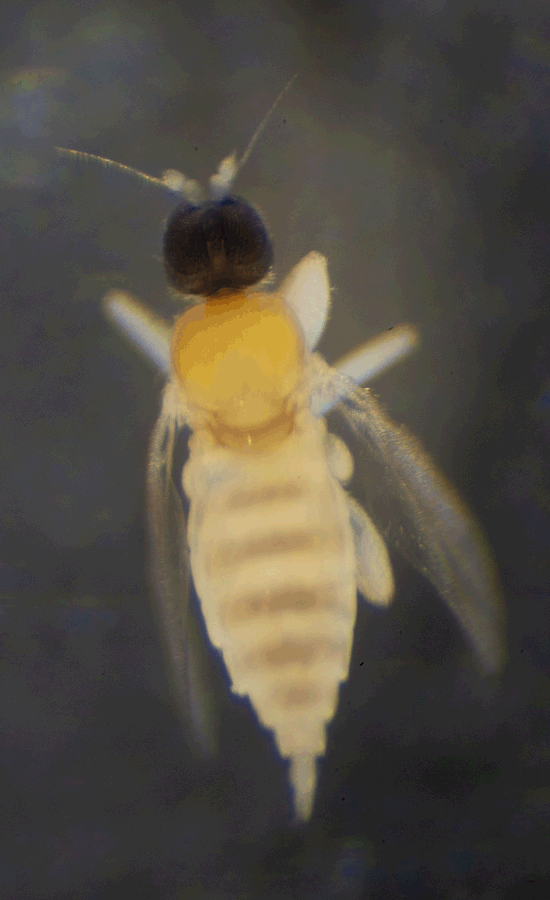
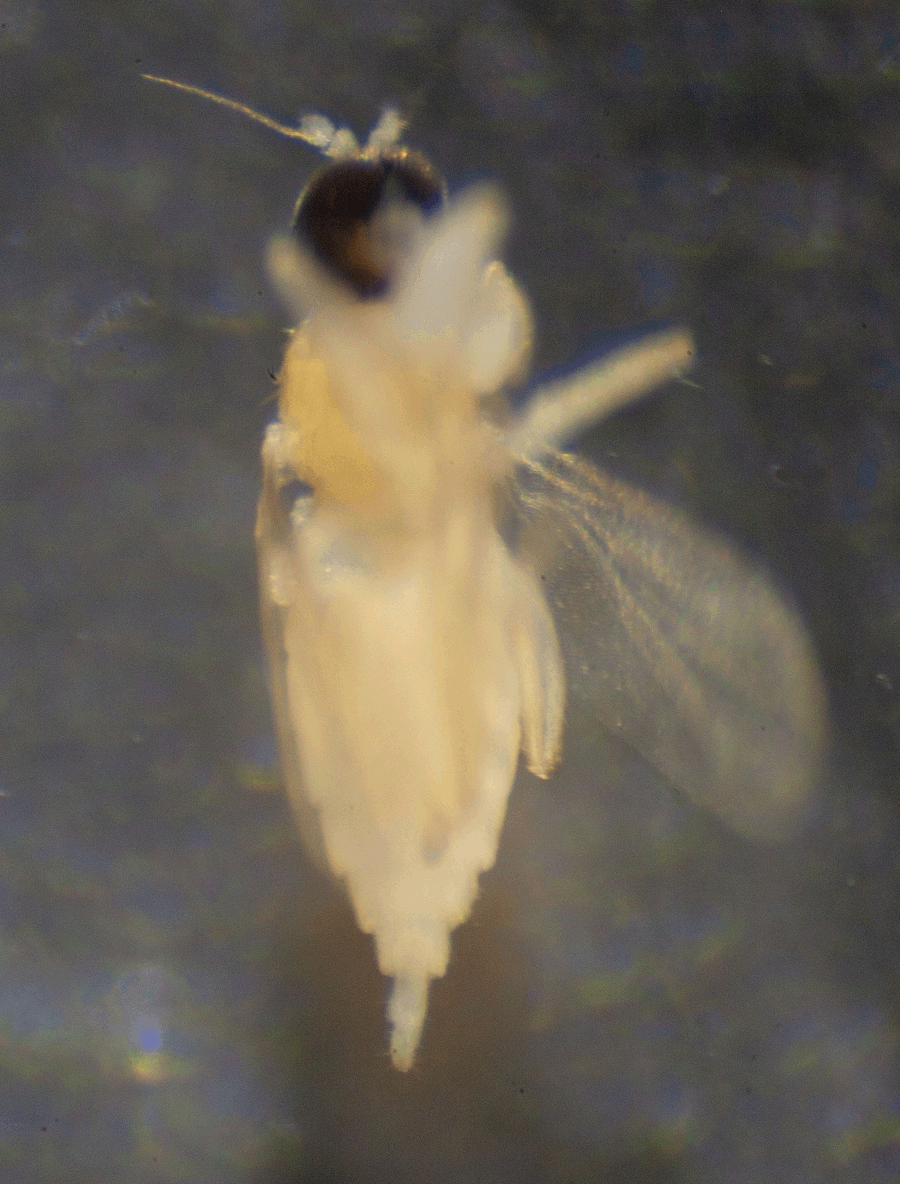








 Superfamily Oestroidea includes the following families of flies: Rhinophoridae (Woodlouse Flies),
Superfamily Oestroidea includes the following families of flies: Rhinophoridae (Woodlouse Flies), 
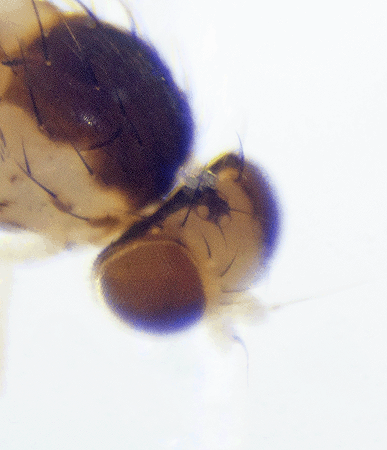

 A female leaf-mining fly uses the stiffened tip of her abdomen to insert eggs between the upper and lower surfaces of host plant leaves. After an egg hatches, the larva begins feeding. It lies sideways as it feeds, creating a characteristic translucent trail or “mine."
A female leaf-mining fly uses the stiffened tip of her abdomen to insert eggs between the upper and lower surfaces of host plant leaves. After an egg hatches, the larva begins feeding. It lies sideways as it feeds, creating a characteristic translucent trail or “mine."  Adult females also feed by puncturing leaves with the ovipositor before feeding on plant juices.
Adult females also feed by puncturing leaves with the ovipositor before feeding on plant juices. 




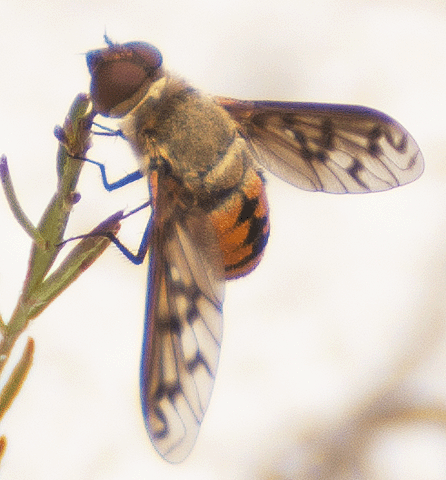 On April 8, 2014, several members of this species were hovering like bees close to the ground in the sandy scrub area of the Smith Preserve. Periodically, they would land either on the sand or on low vegetation. Each fly was estimated to be about 1 cm long.
On April 8, 2014, several members of this species were hovering like bees close to the ground in the sandy scrub area of the Smith Preserve. Periodically, they would land either on the sand or on low vegetation. Each fly was estimated to be about 1 cm long.  As with all members of Family Bombyliidae, larvae of this species are parasitic on the immature stages of other insects; adults sip nectar from flowers.
As with all members of Family Bombyliidae, larvae of this species are parasitic on the immature stages of other insects; adults sip nectar from flowers. 
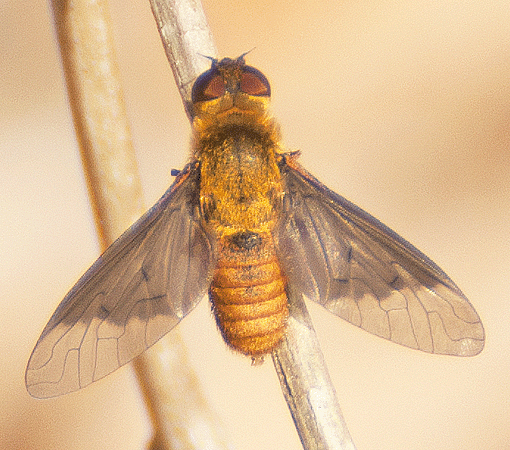




 The male fly at left was photographed on January 28, 2015 as it was resting on a flower petal of a
The male fly at left was photographed on January 28, 2015 as it was resting on a flower petal of a  The oriental latrine fly is a warm -weather fly that infests corpses soon after death, so it can be used in the field of forensics to estimate the time of death. As seen in this photograph, this male adult fly was resting on a dried leaf near the filter marsh in the Smith Preserve on December 23, 2013.
The oriental latrine fly is a warm -weather fly that infests corpses soon after death, so it can be used in the field of forensics to estimate the time of death. As seen in this photograph, this male adult fly was resting on a dried leaf near the filter marsh in the Smith Preserve on December 23, 2013. 
 On January 28, 2015, this blow fly was spotted in the Smith Preserve as it was perched on the leaf of a
On January 28, 2015, this blow fly was spotted in the Smith Preserve as it was perched on the leaf of a 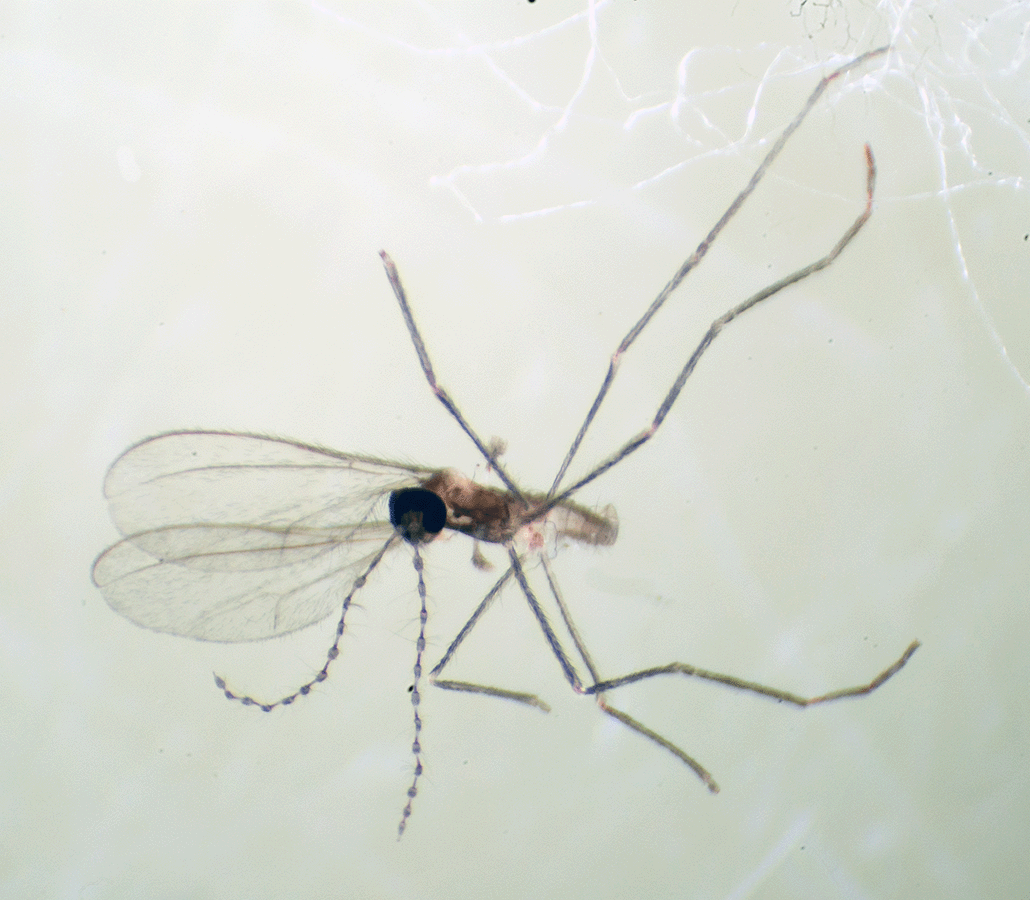




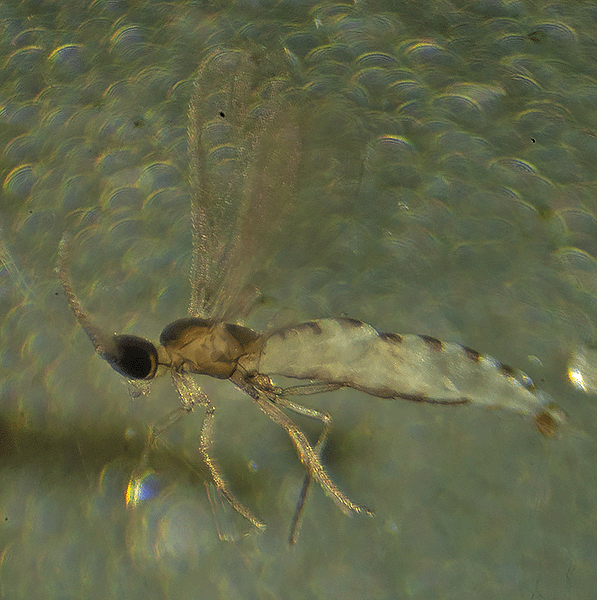
 On December 11, 2024, this 2.5 mm long female midge was captured
On December 11, 2024, this 2.5 mm long female midge was captured 





 Its small size, long legs, long antenna with segments having whorls of hairs, and wings with reduced longitudinal venation led the webmaster to think this is a Cecidomyiid.
Its small size, long legs, long antenna with segments having whorls of hairs, and wings with reduced longitudinal venation led the webmaster to think this is a Cecidomyiid. 

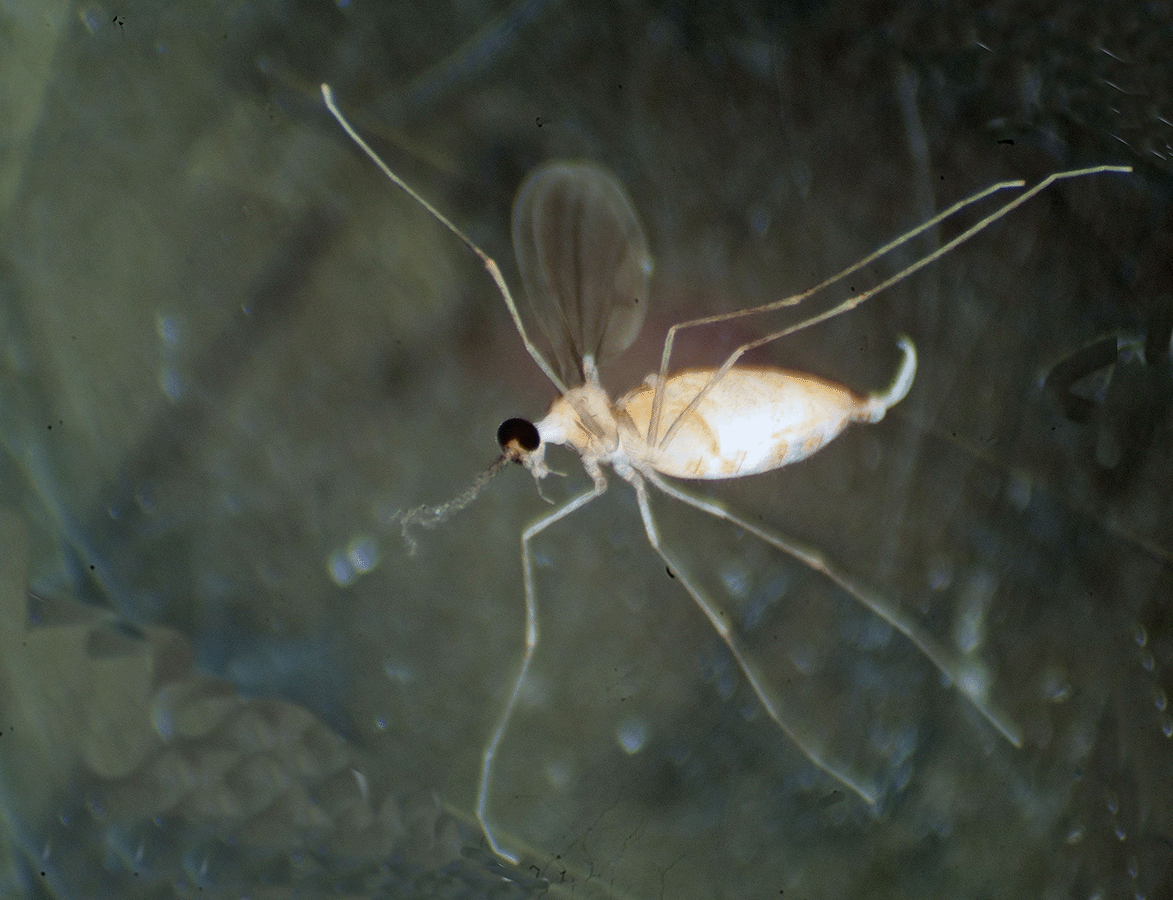
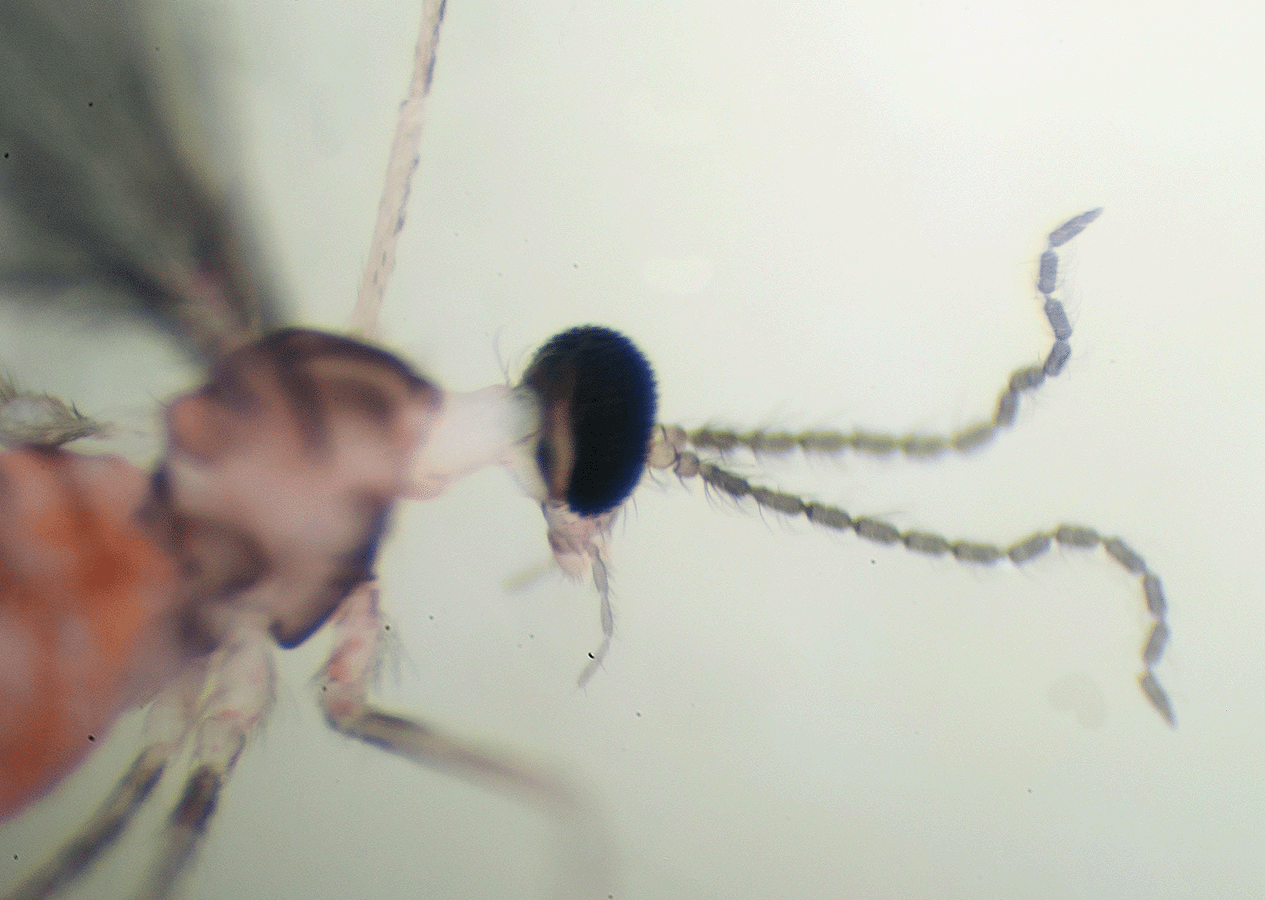
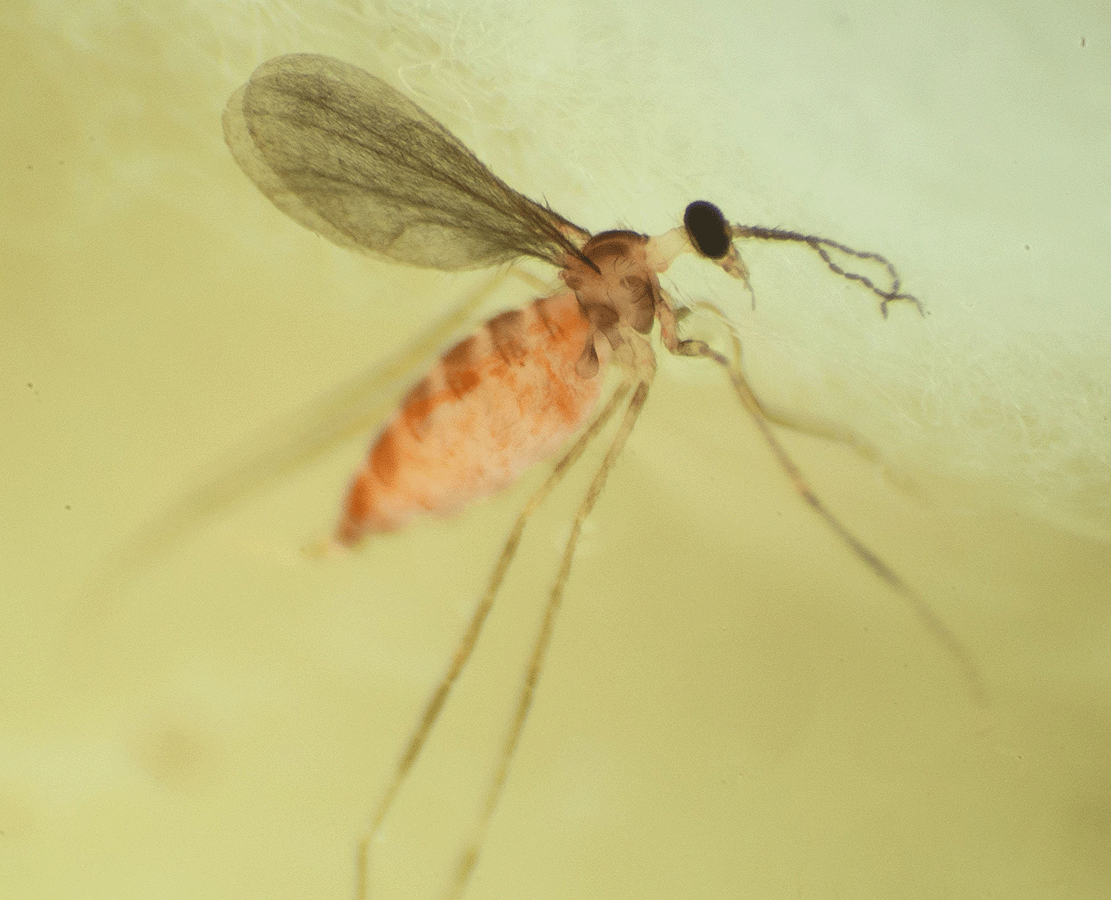


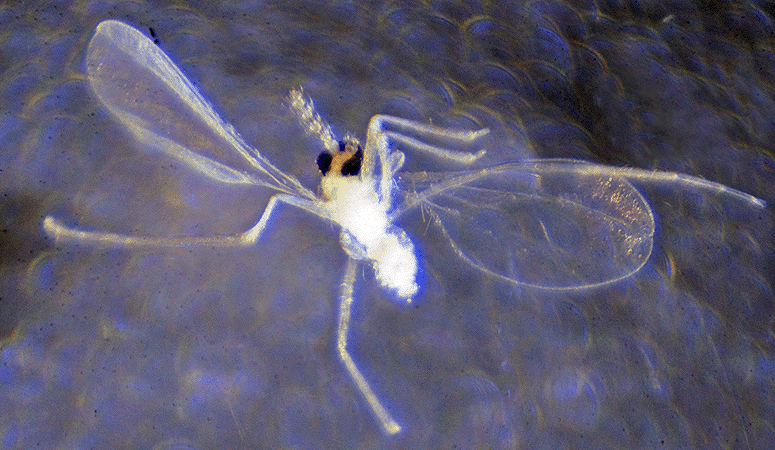
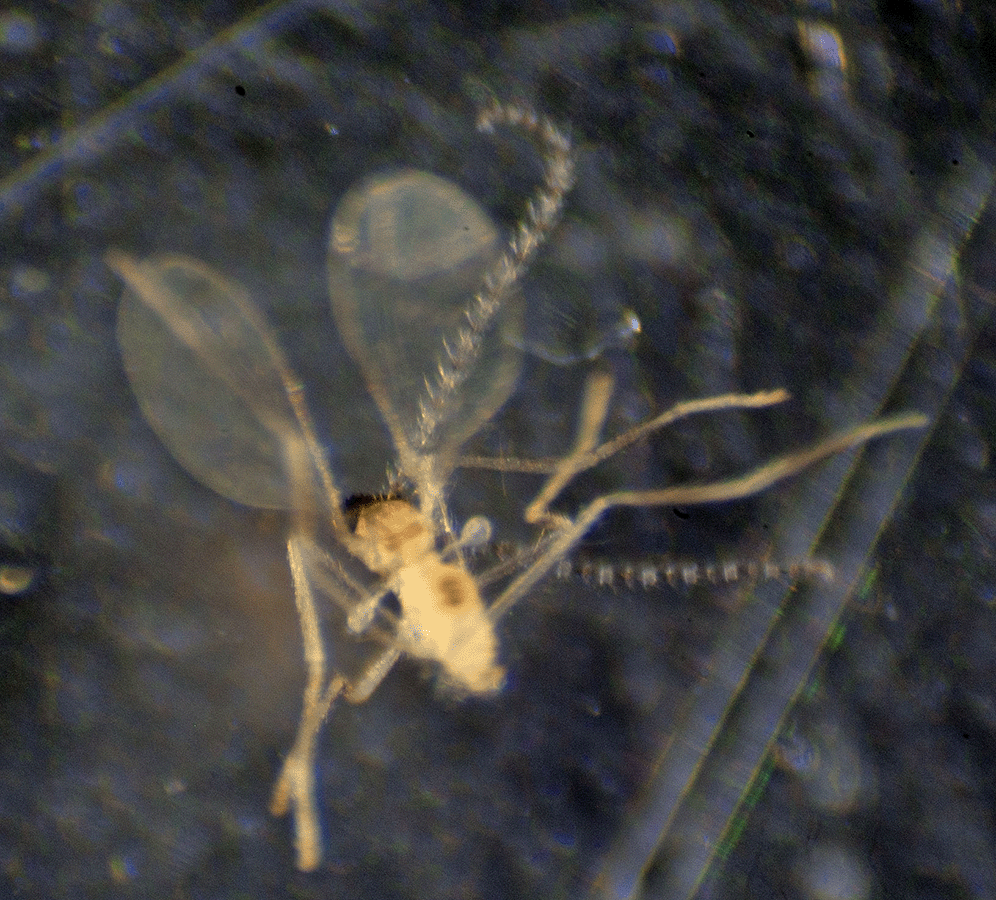






 In the same yellow bowl trap, there were many other Cecidomyiids. The one at right was also 2.5 mm and is a female. John F. Carr, Contributing Editor to <BugGuide.net>, confirmed the Family and sex of this individual on December 11, 2021. Because of its body length, this female may be the same species as the male above, but that has not been determined.
In the same yellow bowl trap, there were many other Cecidomyiids. The one at right was also 2.5 mm and is a female. John F. Carr, Contributing Editor to <BugGuide.net>, confirmed the Family and sex of this individual on December 11, 2021. Because of its body length, this female may be the same species as the male above, but that has not been determined. 

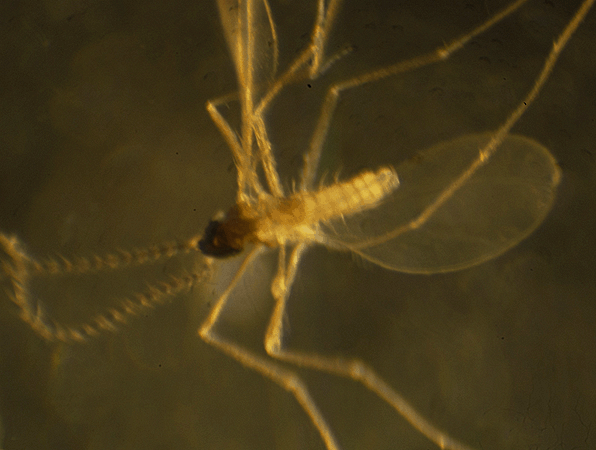
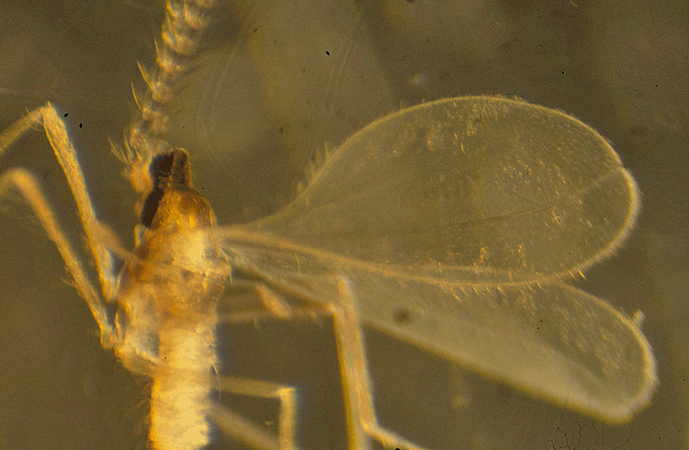
 On November 21, 2023, this 1 mm long Cecidomyiid was collected in leaf litter beneath a
On November 21, 2023, this 1 mm long Cecidomyiid was collected in leaf litter beneath a 





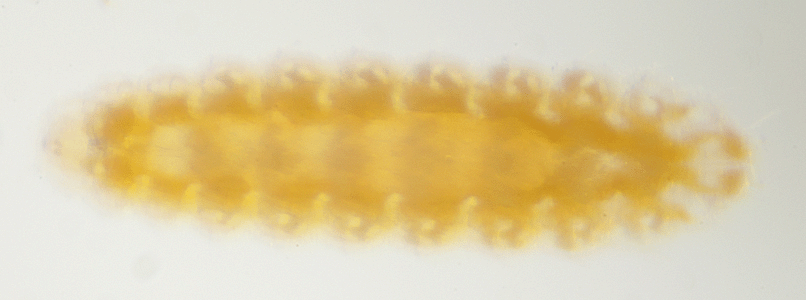
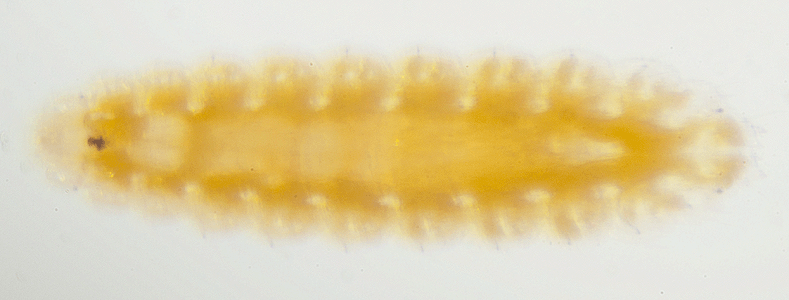
 Photographs were created using photomicroscopy and sent for identification to <BugGuide.net>, sponsored by Iowa State University's Department of Entomology
Photographs were created using photomicroscopy and sent for identification to <BugGuide.net>, sponsored by Iowa State University's Department of Entomology

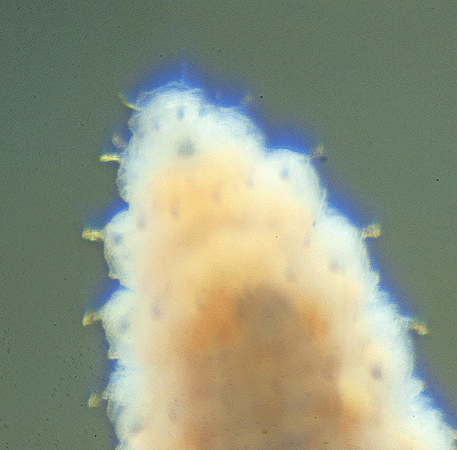 On March 27, 2018, this ~1.1 mm long fly maggot was living in shredded
On March 27, 2018, this ~1.1 mm long fly maggot was living in shredded 


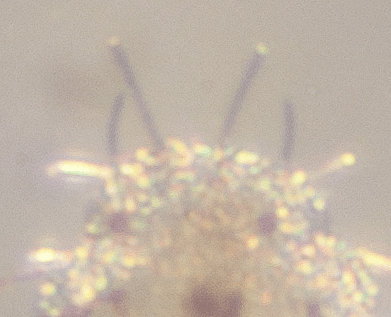
 Brousseau stated, "Not conclusive. Some fly larvae have some distinctive caracteristics underside, but unfortunately, it is not the case here. On the positive side, it eliminates all larvae with caracteristic underside... My best guest so far would be a Cecidomyiidae, but I would need a closer look at the head to be sure. I don't think that it is a Platypezidae as they have fleshy processes which don't seems to be present here."
Brousseau stated, "Not conclusive. Some fly larvae have some distinctive caracteristics underside, but unfortunately, it is not the case here. On the positive side, it eliminates all larvae with caracteristic underside... My best guest so far would be a Cecidomyiidae, but I would need a closer look at the head to be sure. I don't think that it is a Platypezidae as they have fleshy processes which don't seems to be present here." 







 On December 30, 2015, this 1 mm long midge was captured in a sweep net collection obtained in tall grass and other vegetation bordering the northern edge of the Smith Preserve pond.
On December 30, 2015, this 1 mm long midge was captured in a sweep net collection obtained in tall grass and other vegetation bordering the northern edge of the Smith Preserve pond. As stated for the midge above, members of Family Ceratopogonidae are small flies (1 to 4 mm). Females of most species have mouth parts that allow them to suck blood from a host animal.
As stated for the midge above, members of Family Ceratopogonidae are small flies (1 to 4 mm). Females of most species have mouth parts that allow them to suck blood from a host animal. 









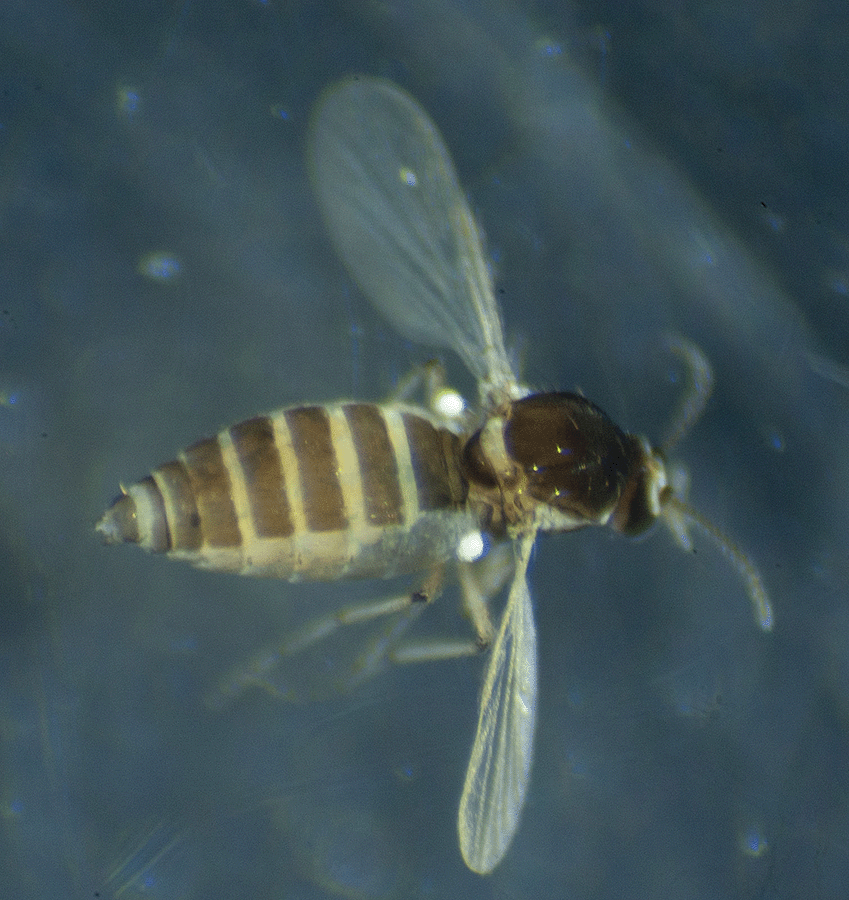
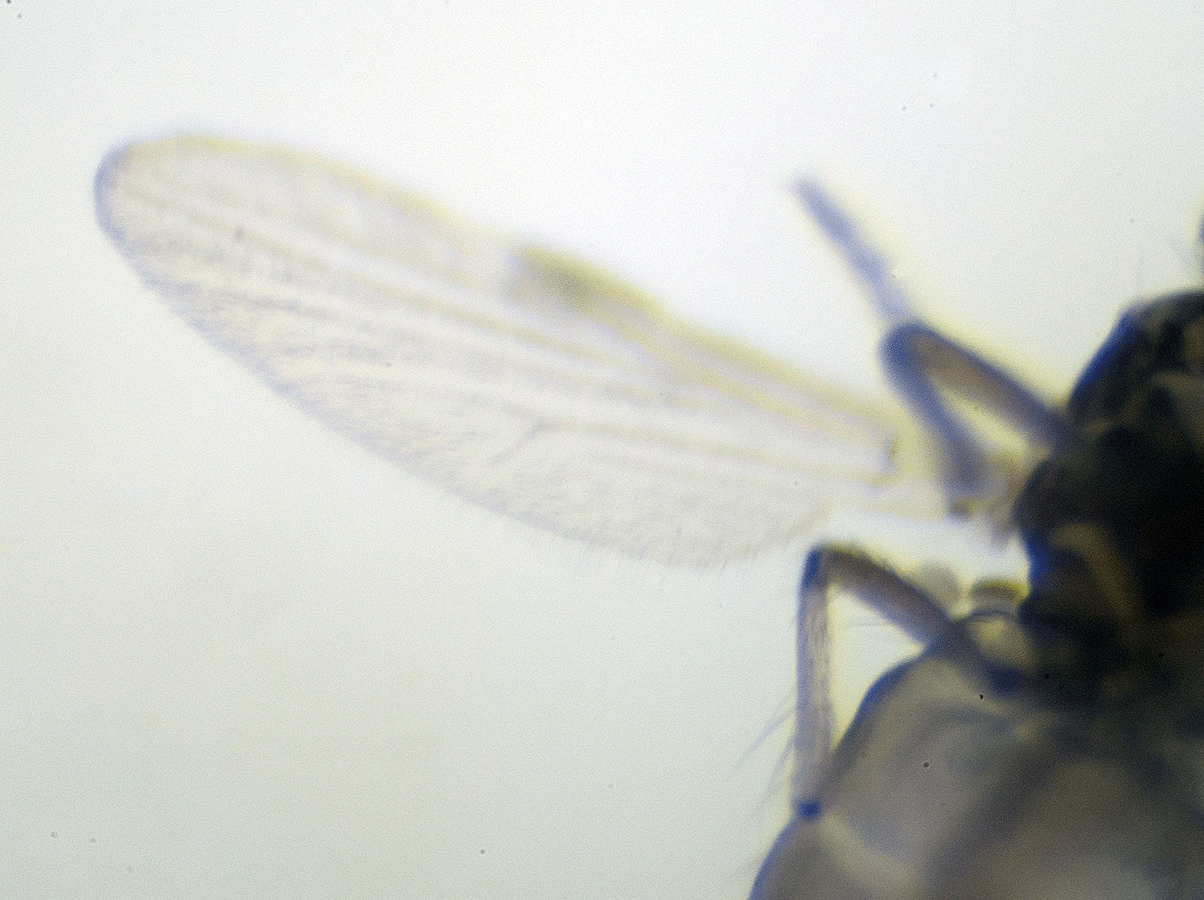
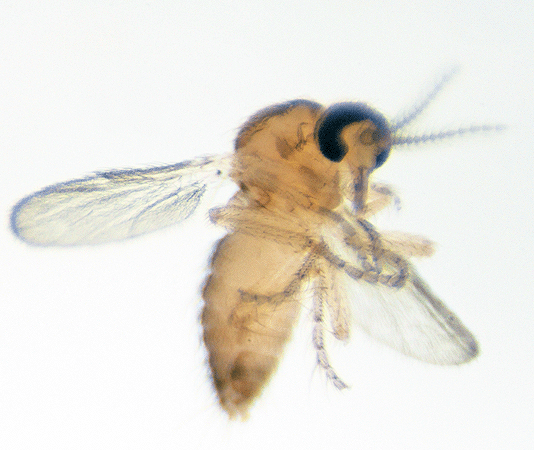



 On January 26, 2016, this 1 mm long fly was captured with a sweep net in low vegetation growing under a cluster of
On January 26, 2016, this 1 mm long fly was captured with a sweep net in low vegetation growing under a cluster of  On November 12, 2012, this 1.5 mm long fly was captured with a sweep net in tall grasses in the Smith Preserve.
On November 12, 2012, this 1.5 mm long fly was captured with a sweep net in tall grasses in the Smith Preserve. 
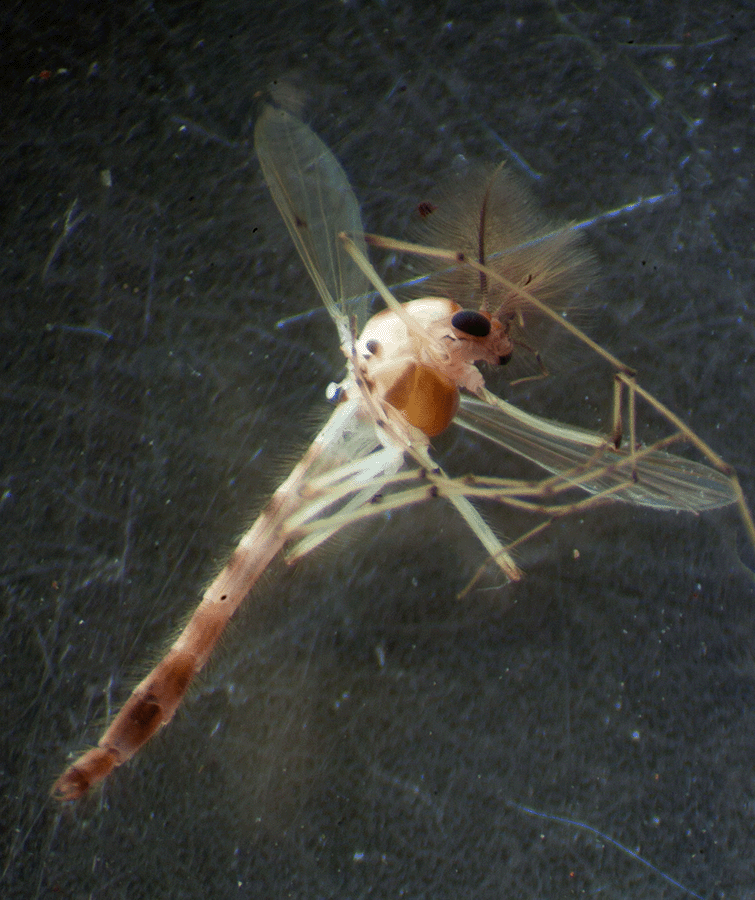


 Most midge larvae are aquatic, with many living in benthic freshwater habitats.
Most midge larvae are aquatic, with many living in benthic freshwater habitats.  In this photograph, some body structures are identified. The head capsule is sclerotized (hardened into plates). The two black dots on the head capsule are its simple eyes. Other black structures on the head capsule are its chewing mouthparts. The fleshy, unsegmented parapods are in pairs and have claws.
In this photograph, some body structures are identified. The head capsule is sclerotized (hardened into plates). The two black dots on the head capsule are its simple eyes. Other black structures on the head capsule are its chewing mouthparts. The fleshy, unsegmented parapods are in pairs and have claws.  On March 11, 2015, this fly was photographed while it was resting on a
On March 11, 2015, this fly was photographed while it was resting on a 






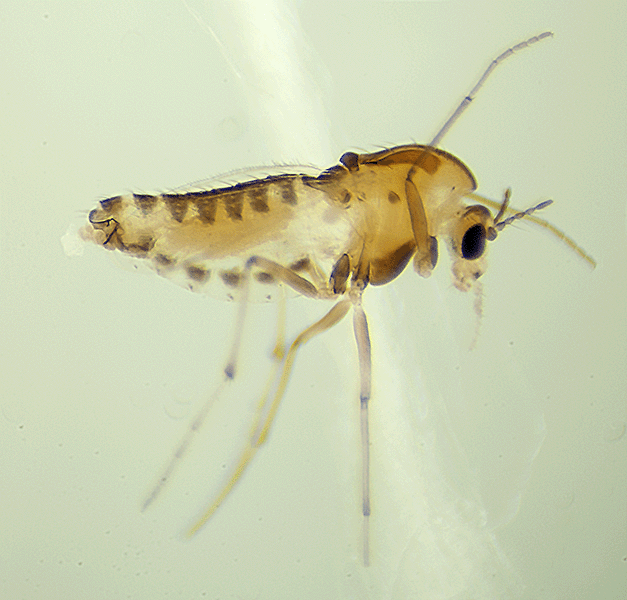








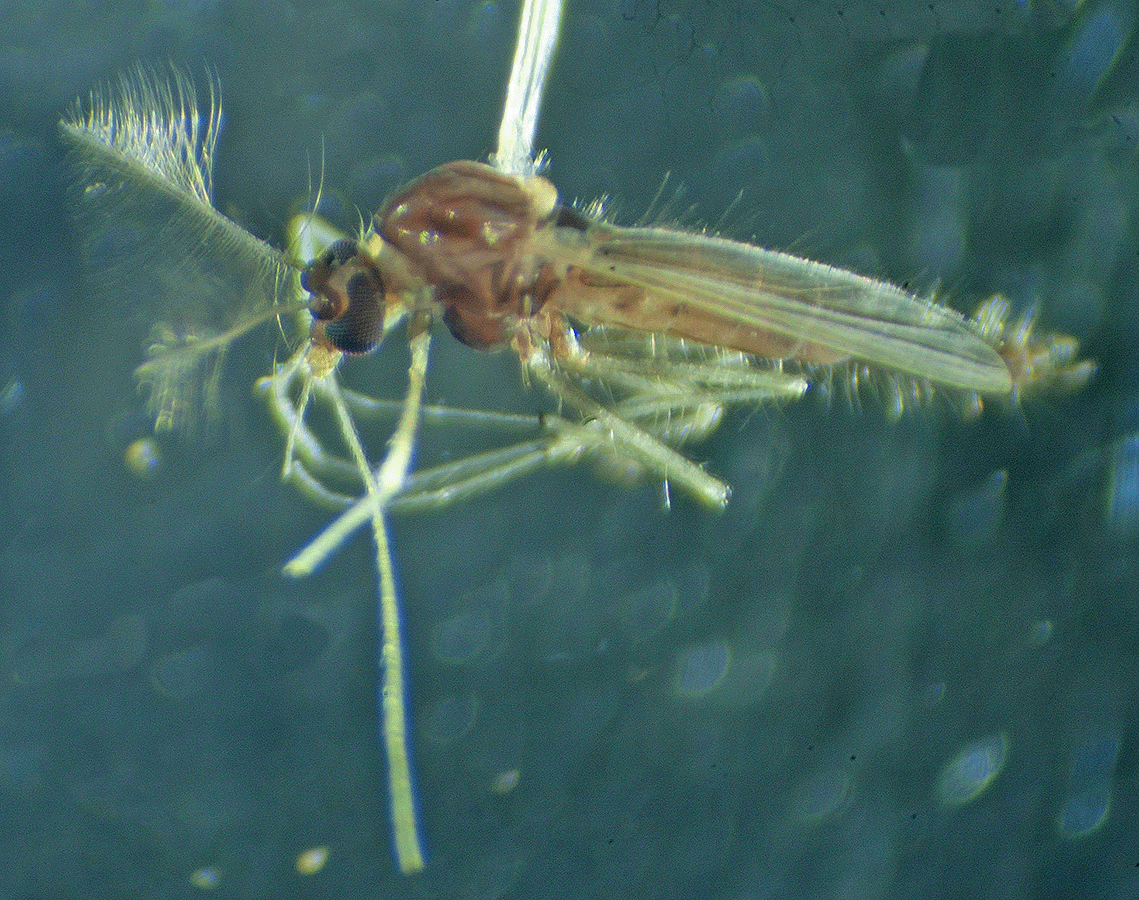

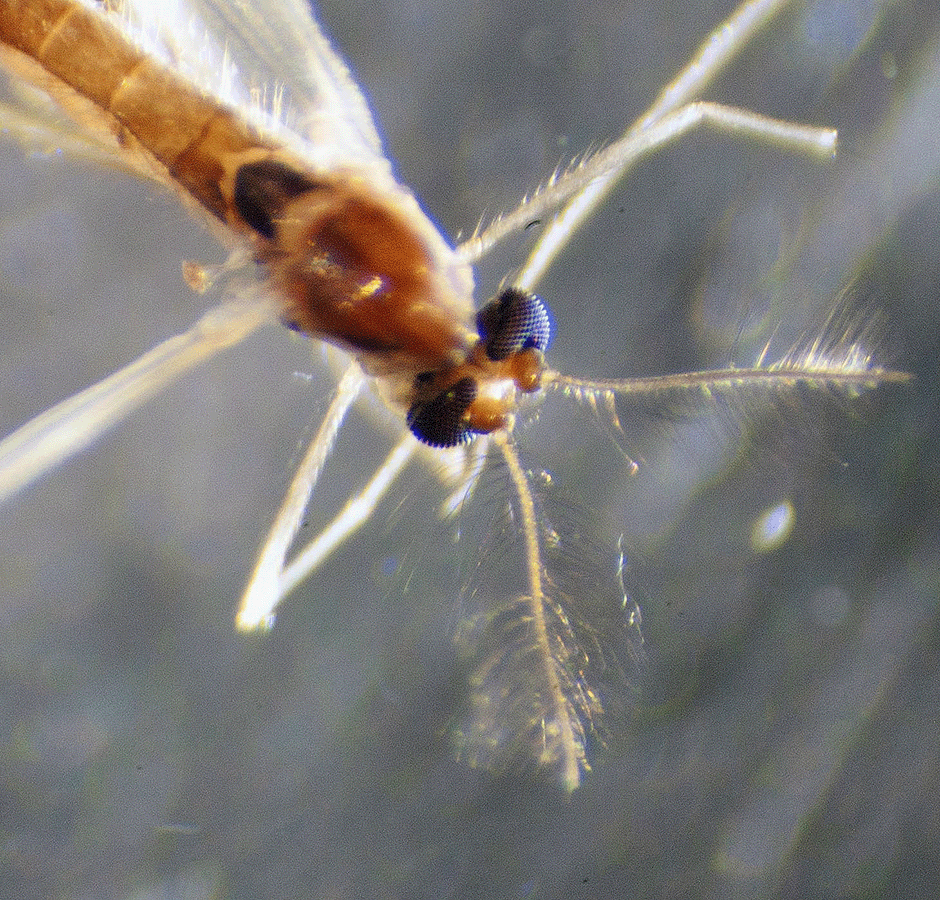
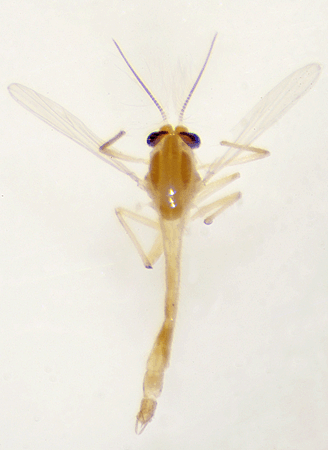 On December 30, 2015, this 2.5 mm long midge was living in tall vegetation growing along the northern edge of the Smith Preserve Pond. It was captured with other invertebrates in a sweep net. These photographs were created using photomicroscopy and sent for identification to <BugGuide.net>, sponsored by Iowa State University's Department of Entomology.
On December 30, 2015, this 2.5 mm long midge was living in tall vegetation growing along the northern edge of the Smith Preserve Pond. It was captured with other invertebrates in a sweep net. These photographs were created using photomicroscopy and sent for identification to <BugGuide.net>, sponsored by Iowa State University's Department of Entomology. 
 The feather-like structures on the antennae are present, but very difficult to see in the first two photographs. The third photograph is a darkened enlargement of the first photograph. The structures appear as tan-colored wisps.
The feather-like structures on the antennae are present, but very difficult to see in the first two photographs. The third photograph is a darkened enlargement of the first photograph. The structures appear as tan-colored wisps. On January 26, 2016, this 3.25 mm long chironomid was captured in a sweep net sample, obtained in low, dry brush that was growing along the eastern gopher tortoise fence in the Smith Preserve.
On January 26, 2016, this 3.25 mm long chironomid was captured in a sweep net sample, obtained in low, dry brush that was growing along the eastern gopher tortoise fence in the Smith Preserve. 

 On January 26, 2016, this 1 mm long fly was captured with a sweep net in low vegetation growing beneath
On January 26, 2016, this 1 mm long fly was captured with a sweep net in low vegetation growing beneath  On December 30, 2015, this 1 mm long fly was caught with a sweep net in low, dry vegetation growing next to the gopher tortoise fence in the northeastern quadrant of Smith Preserve.
On December 30, 2015, this 1 mm long fly was caught with a sweep net in low, dry vegetation growing next to the gopher tortoise fence in the northeastern quadrant of Smith Preserve. 

 On January 4, 2017, this 3 mm long male midge was captured in a yellow bowl trap left overnight in the middle of the Smith Preserve, immediately south of Smith Preserve Way and west of the seasonal pond.
On January 4, 2017, this 3 mm long male midge was captured in a yellow bowl trap left overnight in the middle of the Smith Preserve, immediately south of Smith Preserve Way and west of the seasonal pond. 












 This family of flies is common in grassy areas. The larvae of most species are herbivores, eating grass stems. However, there are exceptions. Some species are scavengers, parasites, and predators. Some are called "eye gnats" because they are attracted to eyes, where they can be vectors of diseases like yaws and pink eye.
This family of flies is common in grassy areas. The larvae of most species are herbivores, eating grass stems. However, there are exceptions. Some species are scavengers, parasites, and predators. Some are called "eye gnats" because they are attracted to eyes, where they can be vectors of diseases like yaws and pink eye. 
 This specimen resembles the frit fly above, with what appear to be only slight differences. The one above has a darker colored ventral abdomen and the dorsal abdomen appears to have stripes, while this one appears to have a light colored ventral abdomen and no stripes on its dorsal abdomen. This individual may or may not be the same species as the one above. That is yet to be determined.
This specimen resembles the frit fly above, with what appear to be only slight differences. The one above has a darker colored ventral abdomen and the dorsal abdomen appears to have stripes, while this one appears to have a light colored ventral abdomen and no stripes on its dorsal abdomen. This individual may or may not be the same species as the one above. That is yet to be determined.  Like the frit fly described above, this 2.5 mm specimen was caught in a sweep net. The net was used to capture arthropods living on the grasses and sedges in the seasonal, dry marsh in the Smith Preserve on December 8, 2014.
Like the frit fly described above, this 2.5 mm specimen was caught in a sweep net. The net was used to capture arthropods living on the grasses and sedges in the seasonal, dry marsh in the Smith Preserve on December 8, 2014. 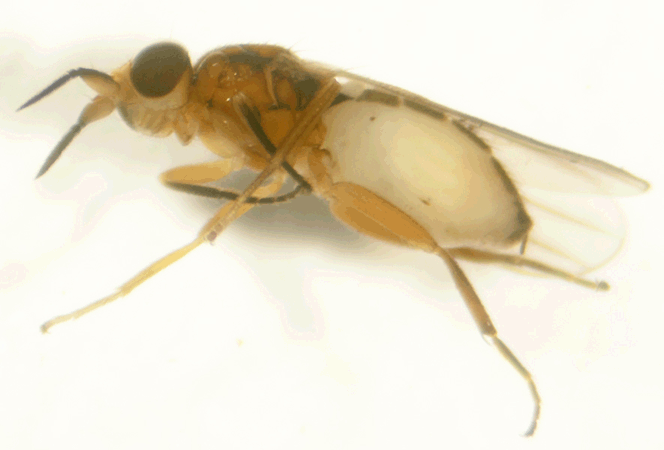


 On January 6, 2016, this 2 mm long fly was captured in a yellow bowl trap placed just south of Smith Preserve Way in the western quadrant of the Smith Preserve. Photographs, created using photomicrography, were submitted for identification to <BugGuide.net>, sponsored by Iowa State University's Department of Entomology.
On January 6, 2016, this 2 mm long fly was captured in a yellow bowl trap placed just south of Smith Preserve Way in the western quadrant of the Smith Preserve. Photographs, created using photomicrography, were submitted for identification to <BugGuide.net>, sponsored by Iowa State University's Department of Entomology.

 Frit flies can be distinguished from other small flies by their small mouthparts and short antennae with rounded third segments and bare aristae (slender bristle). The image shown here is an enlargement of the head of this particular individual. Segments of the antennae are labeled.
Frit flies can be distinguished from other small flies by their small mouthparts and short antennae with rounded third segments and bare aristae (slender bristle). The image shown here is an enlargement of the head of this particular individual. Segments of the antennae are labeled. 





 These photographs were created in 2016 using photomicroscopy, and sent for identification to <BugGuide.net>, sponsored by Iowa State University's Department of Entomology.
These photographs were created in 2016 using photomicroscopy, and sent for identification to <BugGuide.net>, sponsored by Iowa State University's Department of Entomology. 




 On Ap
On Ap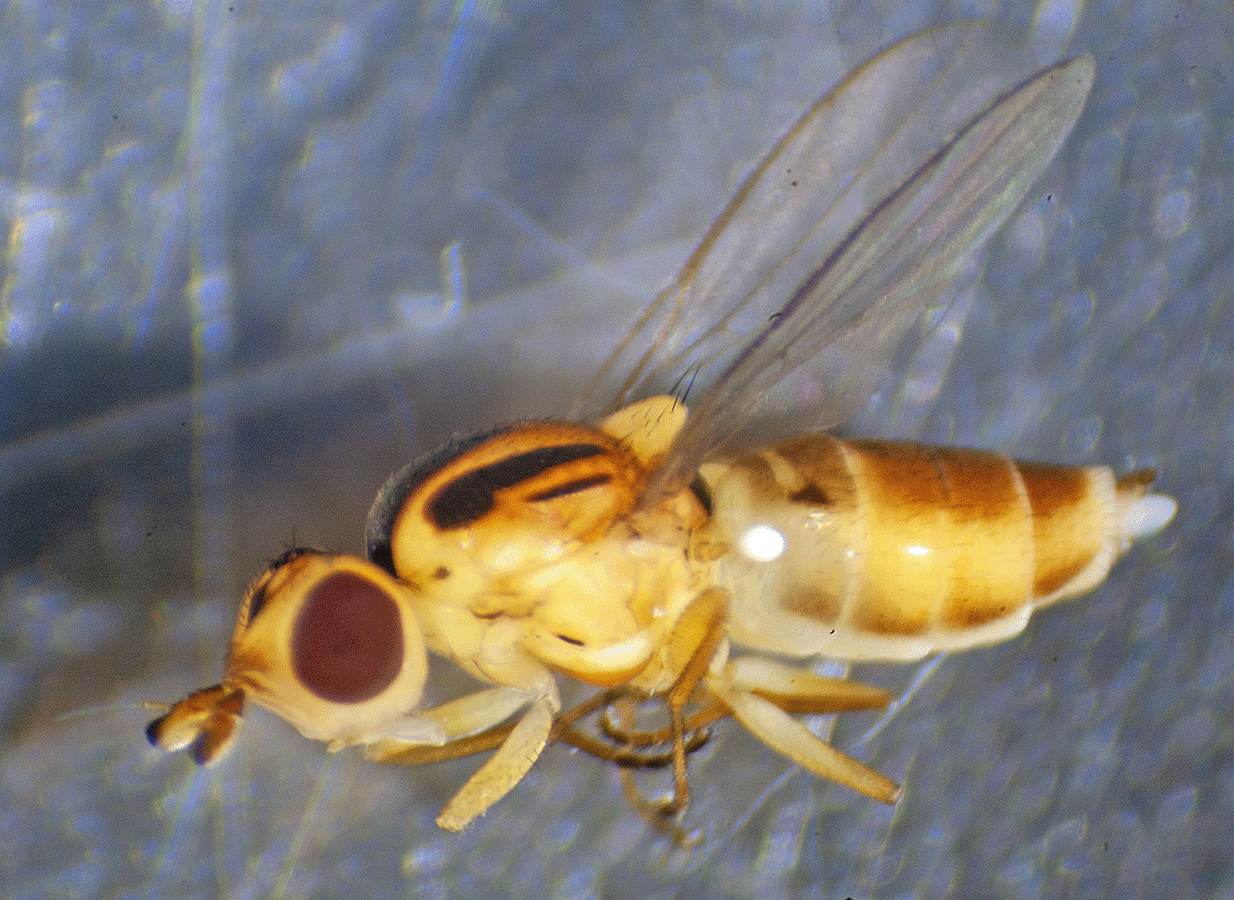



 The species was identified on May 10, 2015 by JBurger, Contributor to <BugGuide.net>, sponsored by Iowa State University Department of Entomology.
The species was identified on May 10, 2015 by JBurger, Contributor to <BugGuide.net>, sponsored by Iowa State University Department of Entomology. On April 28, 2014, the mosquito shown was attempting to withdraw blood from the webmaster in the scrub area of the Smith Preserve.
On April 28, 2014, the mosquito shown was attempting to withdraw blood from the webmaster in the scrub area of the Smith Preserve. 


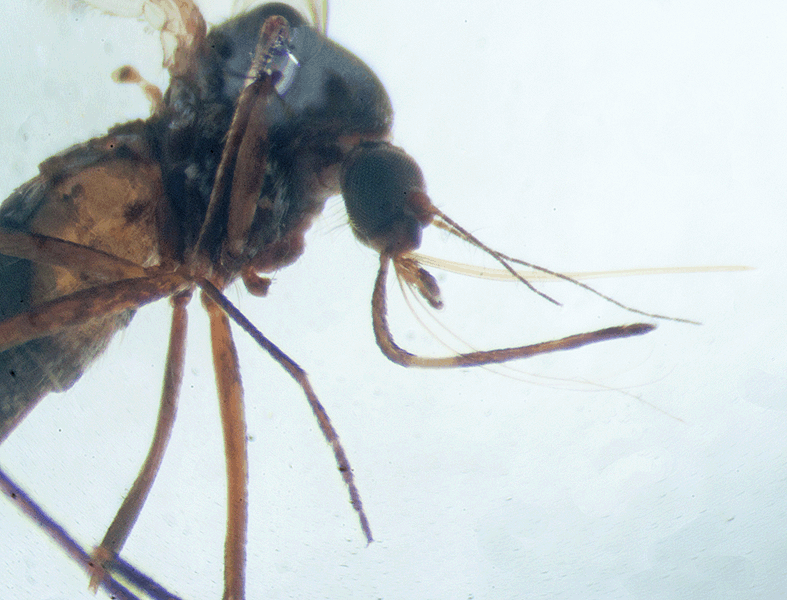





 On January 11, 2017, this 6.5 mm long mosquito wiggler was captured in a net at the Smith Preserve Marsh by Leif Johnson, a Conservancy of SW FL scientist.
On January 11, 2017, this 6.5 mm long mosquito wiggler was captured in a net at the Smith Preserve Marsh by Leif Johnson, a Conservancy of SW FL scientist.  This webmaster suspects that the genus is Culex because it has a siphon (breathing tube) present with pecten and more than two hair tufts beyond the pecten (see image at right). Pecten are a comb-like row of spicules borne posterolaterally on the basal part of the siphon.
This webmaster suspects that the genus is Culex because it has a siphon (breathing tube) present with pecten and more than two hair tufts beyond the pecten (see image at right). Pecten are a comb-like row of spicules borne posterolaterally on the basal part of the siphon.  On March 28, 2018, this 5.5 mm long fly was captured in a yellow bowl trap left overnight in the middle of the Smith Preserve near
On March 28, 2018, this 5.5 mm long fly was captured in a yellow bowl trap left overnight in the middle of the Smith Preserve near 



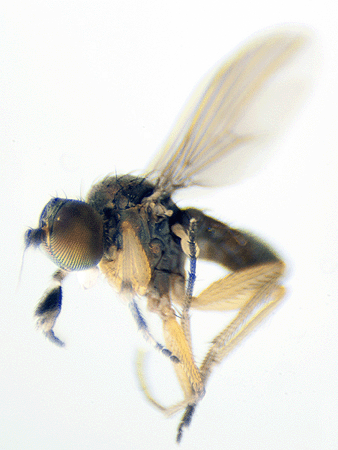





 On November 17, 2021, this 2.1 mm long male fly was removed from a yellow bowl trap that had been left overnight in a hammock that was south of the Christopher B. Smith pond and west of the gopher tortoise fence.
On November 17, 2021, this 2.1 mm long male fly was removed from a yellow bowl trap that had been left overnight in a hammock that was south of the Christopher B. Smith pond and west of the gopher tortoise fence. 
 <
<



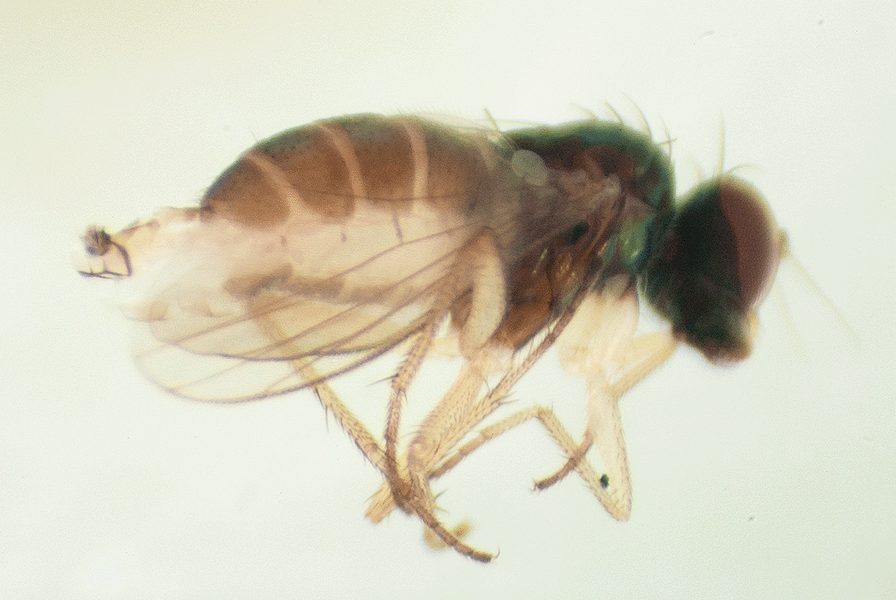
 On March 3, 2016, this 2.5 mm long, female fly was captured in a pitfall trap that had been left over night in sand adjacent to a
On March 3, 2016, this 2.5 mm long, female fly was captured in a pitfall trap that had been left over night in sand adjacent to a 











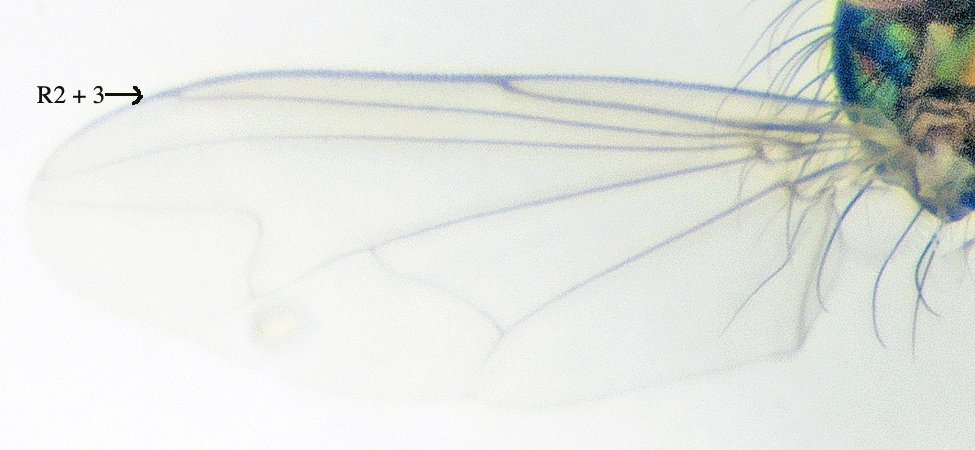 The wing of the Condylostylus comatus group is sometimes darkened along the front edge near the tip of R2 +3.
The wing of the Condylostylus comatus group is sometimes darkened along the front edge near the tip of R2 +3. 



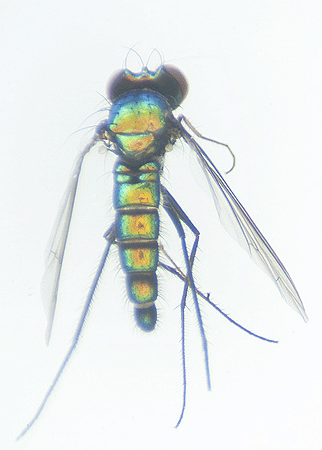

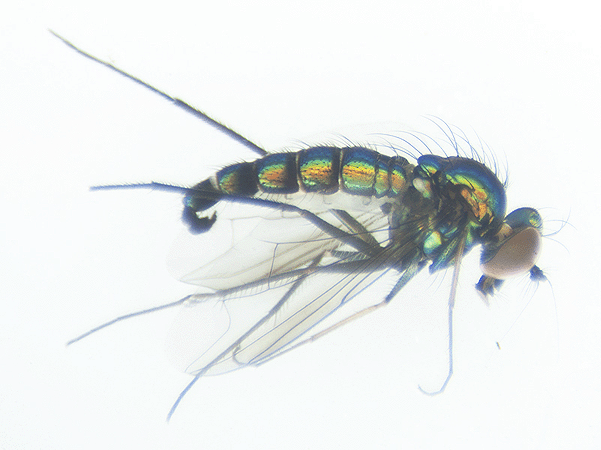





 On December 20, 2018, the genus Condylostylus was identified by John F. Carr, Contributing Editor to <Bugguide.net>. On December 1, 2022, the species longicornis was identified by Zachary Dankowisz, a Contributing Editor of <Bugguide.net.)
On December 20, 2018, the genus Condylostylus was identified by John F. Carr, Contributing Editor to <Bugguide.net>. On December 1, 2022, the species longicornis was identified by Zachary Dankowisz, a Contributing Editor of <Bugguide.net.) In North America, there are at least 1,275 species in Family Dolichopodidae. Family members include small to minute flies that are usually metallic green, blue, copper, or bronze. They have bulging and widely separated eyes and legs with three rows of evenly spaced short black spines.
In North America, there are at least 1,275 species in Family Dolichopodidae. Family members include small to minute flies that are usually metallic green, blue, copper, or bronze. They have bulging and widely separated eyes and legs with three rows of evenly spaced short black spines. 








 These photographs were created using photomicroscopy and sent for identification to <BugGuide.net>.
These photographs were created using photomicroscopy and sent for identification to <BugGuide.net>. 






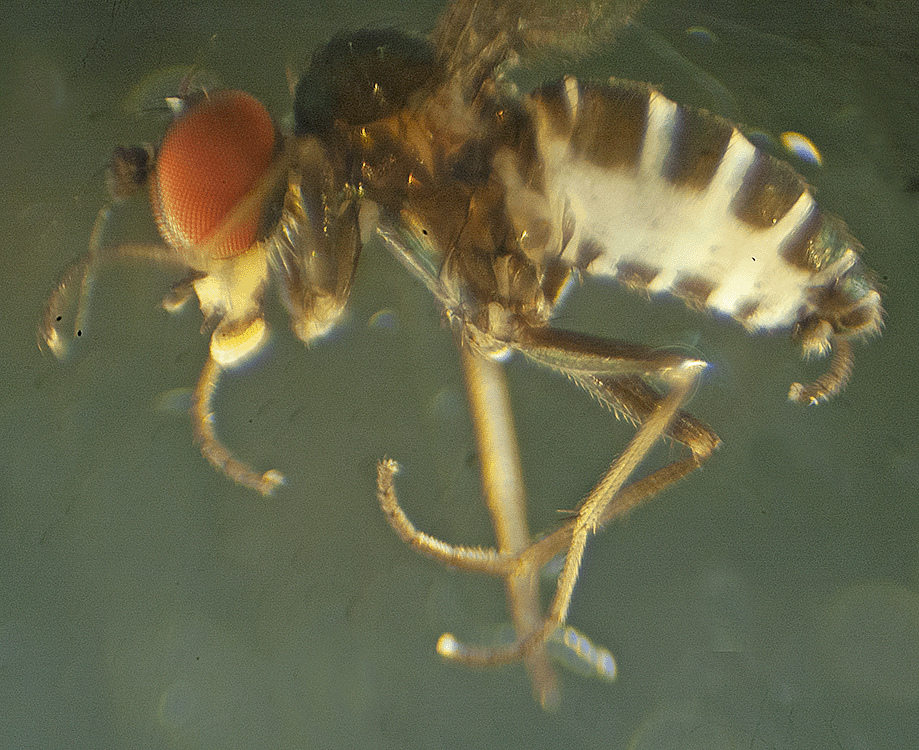


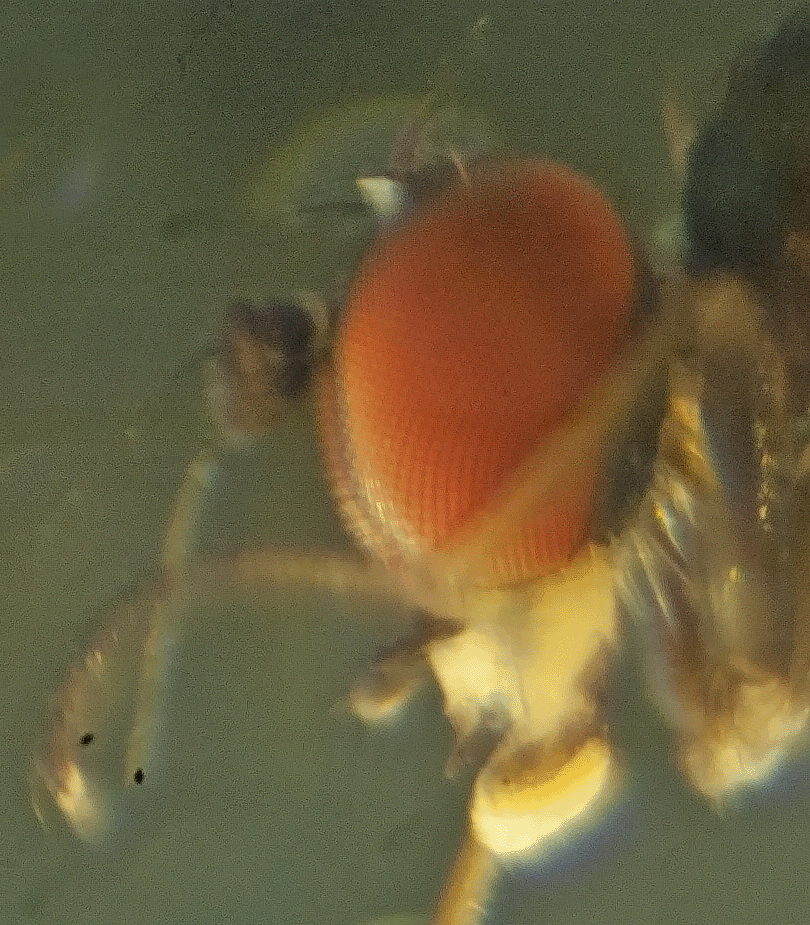 On April 19, 2023, the Subfamily was identified by Zachary Dankowicz, a Contributing Editor of <Bugguide.net>. Members of Subfamily Diaphorinae are variable in size, but common species are 2-3 mm long.
On April 19, 2023, the Subfamily was identified by Zachary Dankowicz, a Contributing Editor of <Bugguide.net>. Members of Subfamily Diaphorinae are variable in size, but common species are 2-3 mm long.
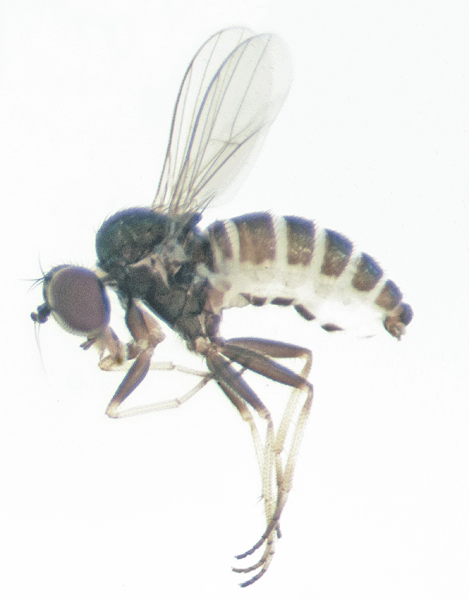

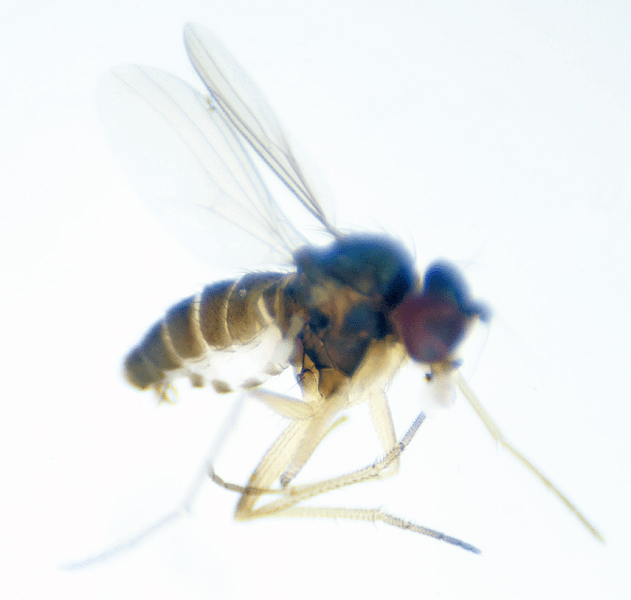
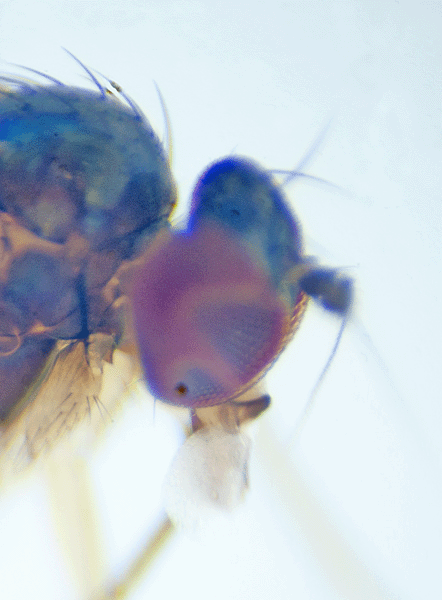



 On November 28, 2014, this small fly was photographed as it was resting on the top surface of a leaf of Colocasia esculenta (Wild Taro) that was growing adjacent to the pond in the Smith Preserve.
On November 28, 2014, this small fly was photographed as it was resting on the top surface of a leaf of Colocasia esculenta (Wild Taro) that was growing adjacent to the pond in the Smith Preserve. 



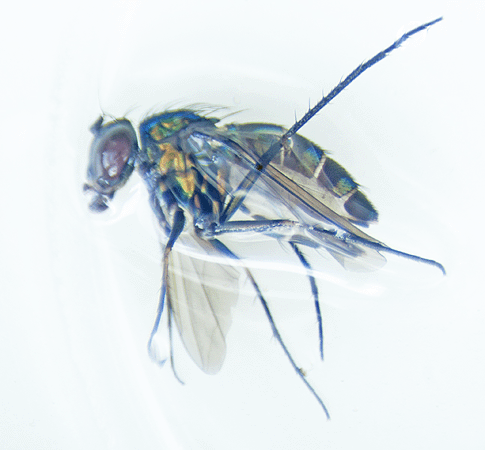 Images were created using photomicroscopy and sent for identification to <BugGuide.net>, sponsored by Iowa State University's Department of Entomology. On December 28, 2018, the species was identified by John F. Carr, a Contributing Editor to <BugGuide.net>.
Images were created using photomicroscopy and sent for identification to <BugGuide.net>, sponsored by Iowa State University's Department of Entomology. On December 28, 2018, the species was identified by John F. Carr, a Contributing Editor to <BugGuide.net>.  The species name "univittatus" means "one stripe" and refers to the red stripe on the thorax, as shown in images 1 and 2 above.
The species name "univittatus" means "one stripe" and refers to the red stripe on the thorax, as shown in images 1 and 2 above.




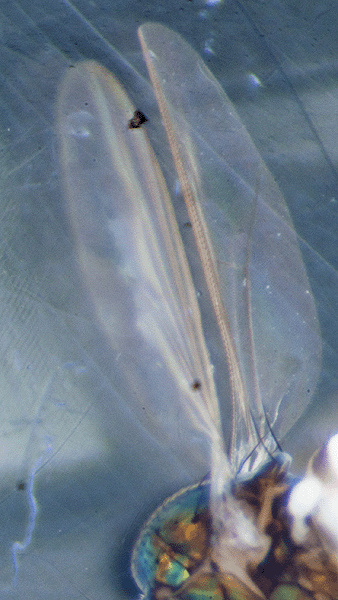



 The fly shown here was identified on November 25, 2014 from these photographs by John F. Carr, Contributing Editor of <BugGuide.net>, sponsored by Iowa State University Entomology Department. He stated that it is probably a member of Subfamily Diaphorinae. On December, 2019, John Carr confirmed the Subfamily.
The fly shown here was identified on November 25, 2014 from these photographs by John F. Carr, Contributing Editor of <BugGuide.net>, sponsored by Iowa State University Entomology Department. He stated that it is probably a member of Subfamily Diaphorinae. On December, 2019, John Carr confirmed the Subfamily.  This metallic copper-colored fly was walking on the bottom surface of a leaf of
This metallic copper-colored fly was walking on the bottom surface of a leaf of 










 On December 13, 2016, this 3.5 mm long female fly was captured in the same yellow bowl trap as the male fly shown above. The trap had been left overnight in an open sandy area of the Smith Preserve near 14th Ave N and a private residence.
On December 13, 2016, this 3.5 mm long female fly was captured in the same yellow bowl trap as the male fly shown above. The trap had been left overnight in an open sandy area of the Smith Preserve near 14th Ave N and a private residence. 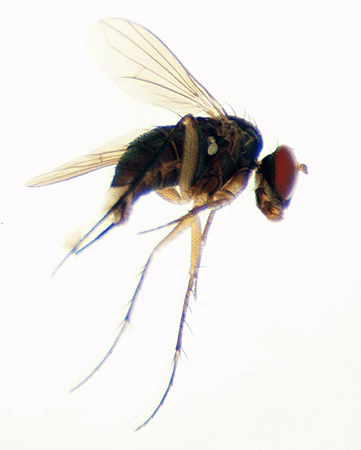
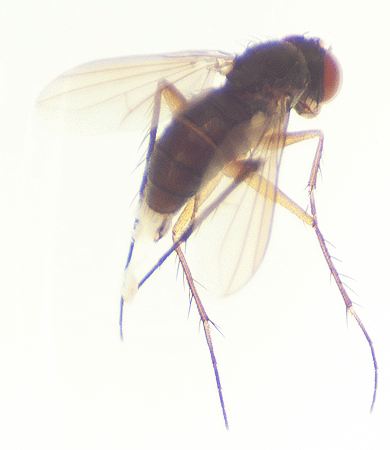






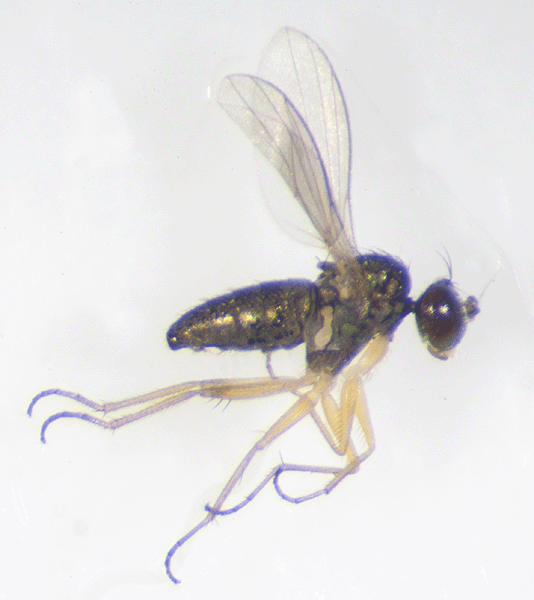
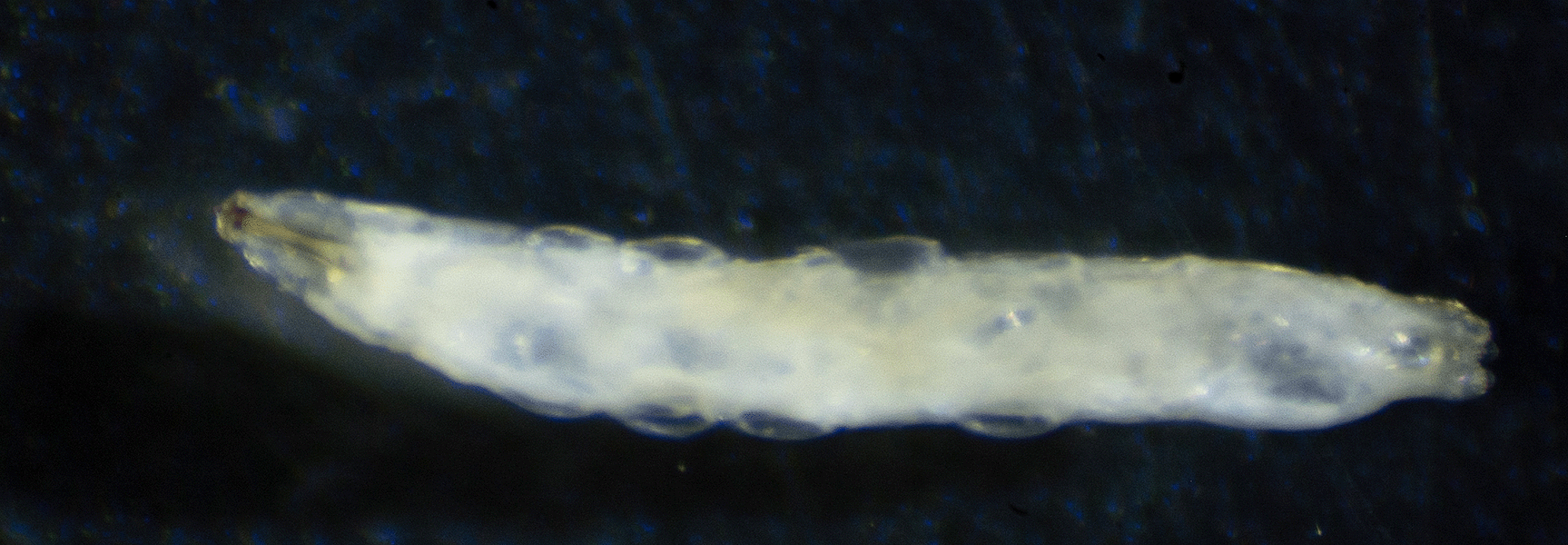









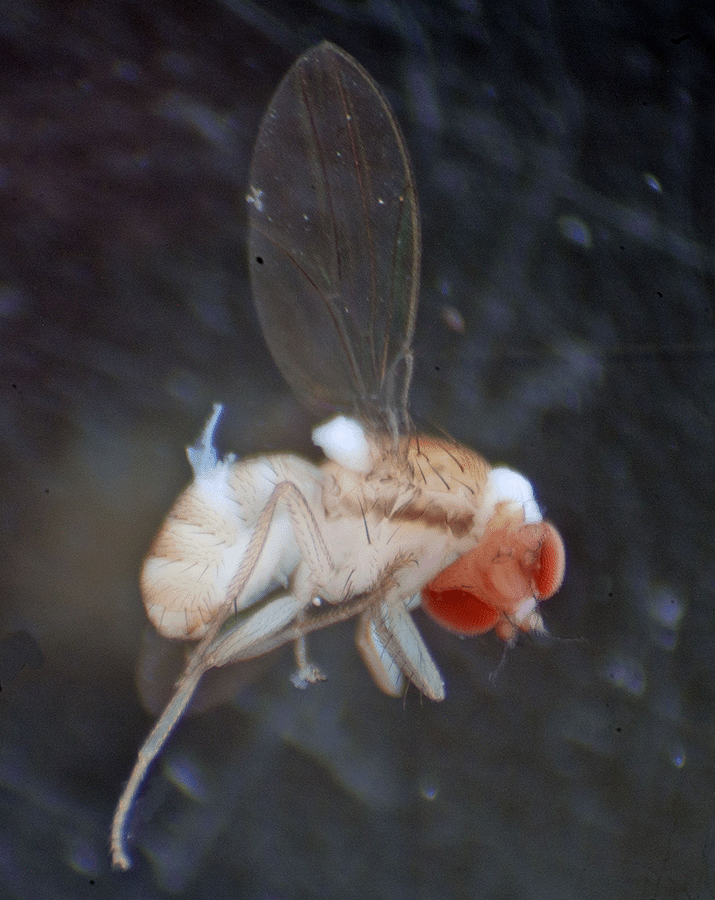




 The species is easily recognized by its red eyes and two distinctive white longitudinal stripes bordered by black stripes that extend from the antenna to the tip of the thorax. An additional set of stripes are located along the thorax laterally to the edge of the wing base.
The species is easily recognized by its red eyes and two distinctive white longitudinal stripes bordered by black stripes that extend from the antenna to the tip of the thorax. An additional set of stripes are located along the thorax laterally to the edge of the wing base.  On March 4, 2015, these fruit flies, along with African fig flies described above, were spotted covering
On March 4, 2015, these fruit flies, along with African fig flies described above, were spotted covering  On March 15, 2015, the family was confirmed from the first image by John F. Carr, Contributing Editor of <BugGuide.net>, sponsored by Iowa State University Department of Entomology.
On March 15, 2015, the family was confirmed from the first image by John F. Carr, Contributing Editor of <BugGuide.net>, sponsored by Iowa State University Department of Entomology. Most species of Drosophilidae are considered a nuisance rather than a pest because they breed in rotting material. However, in natural environments they are a common vector in propagating acetic acid bacteria.
Most species of Drosophilidae are considered a nuisance rather than a pest because they breed in rotting material. However, in natural environments they are a common vector in propagating acetic acid bacteria. 


 On March 28, 2018, this 2.4 mm long fly was captured in a yellow bowl trap left overnight in the middle of the Smith Preserve near several
On March 28, 2018, this 2.4 mm long fly was captured in a yellow bowl trap left overnight in the middle of the Smith Preserve near several  According to <BugGuide.net>, members of Family Empididae are "small to medium sized flies, usually elongated and mostly dark colored. They have a rounded head and distinct neck, a large and humpbacked thorax and long tapered abdomen.
According to <BugGuide.net>, members of Family Empididae are "small to medium sized flies, usually elongated and mostly dark colored. They have a rounded head and distinct neck, a large and humpbacked thorax and long tapered abdomen.  dance. They have captured an insect, wrapped it in silk, and hold as an offering for females. Females seem to choose the male with the most enticing offering. Sometimes a male may offer just an empty ball of silk."
dance. They have captured an insect, wrapped it in silk, and hold as an offering for females. Females seem to choose the male with the most enticing offering. Sometimes a male may offer just an empty ball of silk."  On December 8. 2014, this 2.5 mm fly was caught with a sweep net in the dry seasonal marsh at the Smith Preserve.
On December 8. 2014, this 2.5 mm fly was caught with a sweep net in the dry seasonal marsh at the Smith Preserve. 
 On December 9, 2023, Zachary Dankowicz, a Contributing Editor of <Bugguide.net> identified the Subfamily as Discomyzinae.
On December 9, 2023, Zachary Dankowicz, a Contributing Editor of <Bugguide.net> identified the Subfamily as Discomyzinae.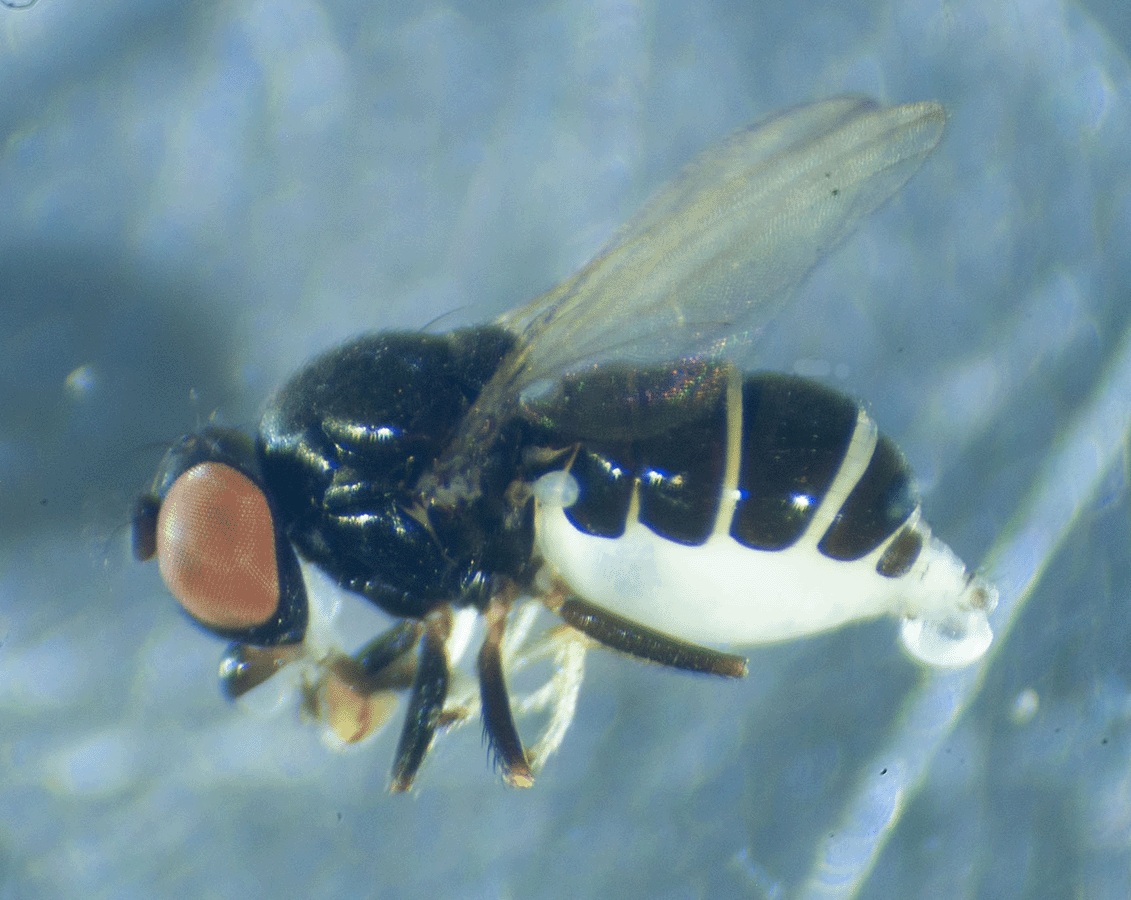


 On December 30, 2015, this 2.6 mm long fly was captured in a sweep net, used in low vegetation growing along the eastern gopher tortoise fence, south of Smith Preserve Way.
On December 30, 2015, this 2.6 mm long fly was captured in a sweep net, used in low vegetation growing along the eastern gopher tortoise fence, south of Smith Preserve Way.  On December 30, 2015, this 2.6 mm long fly was captured in a sweep net, used in dry brush growing along the eastern gopher tortoise fence, south of Smith Preserve Way.
On December 30, 2015, this 2.6 mm long fly was captured in a sweep net, used in dry brush growing along the eastern gopher tortoise fence, south of Smith Preserve Way. 


 Shore flies are tiny flies found near water. This individual, only 2 mm long, was captured with a sweep net in the dry, seasonal marsh, dominated by grasses and sedges, at the Smith Preserve on December 8, 2014.
Shore flies are tiny flies found near water. This individual, only 2 mm long, was captured with a sweep net in the dry, seasonal marsh, dominated by grasses and sedges, at the Smith Preserve on December 8, 2014.  There are 1,800 species in the family and 120 species of the subfamily that have been described.
There are 1,800 species in the family and 120 species of the subfamily that have been described.  As explained above, shore flies are tiny flies found near water. This individual, only 3 mm long, was captured in the same sweep net sample as the fly described above. The collection was made in the dry, seasonal marsh, dominated by grasses and sedges, at the Smith Preserve on December 8, 2014.
As explained above, shore flies are tiny flies found near water. This individual, only 3 mm long, was captured in the same sweep net sample as the fly described above. The collection was made in the dry, seasonal marsh, dominated by grasses and sedges, at the Smith Preserve on December 8, 2014.

 On September 22, 2024, the family and subfamily were identified by John F. Carr, a Contributing Editor of <Bugguide.net>.
On September 22, 2024, the family and subfamily were identified by John F. Carr, a Contributing Editor of <Bugguide.net>.



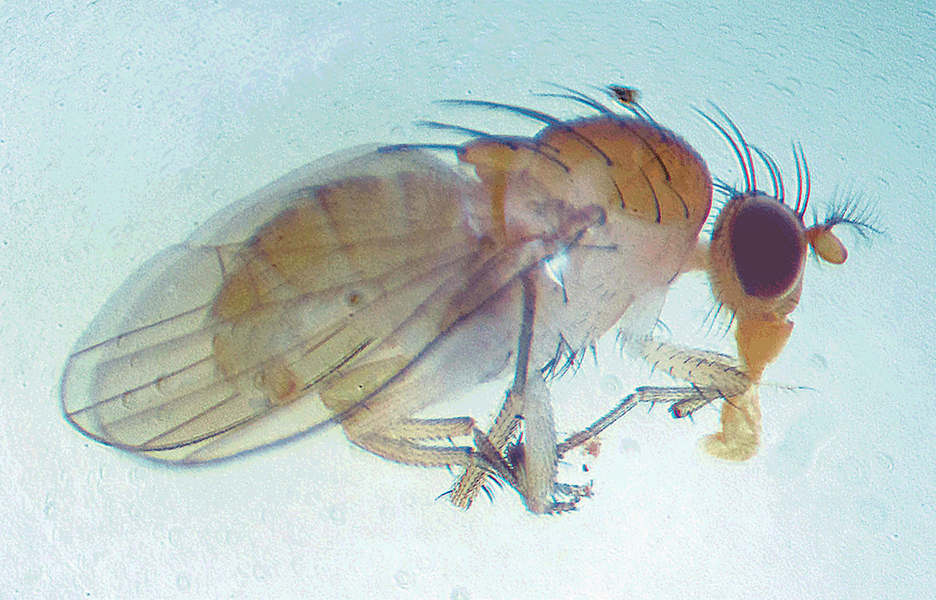


 On February 3, 2024, this 3.6 mm long fly was captured with the two flies shown directly above in a sweep net used in a tangle of
On February 3, 2024, this 3.6 mm long fly was captured with the two flies shown directly above in a sweep net used in a tangle of 



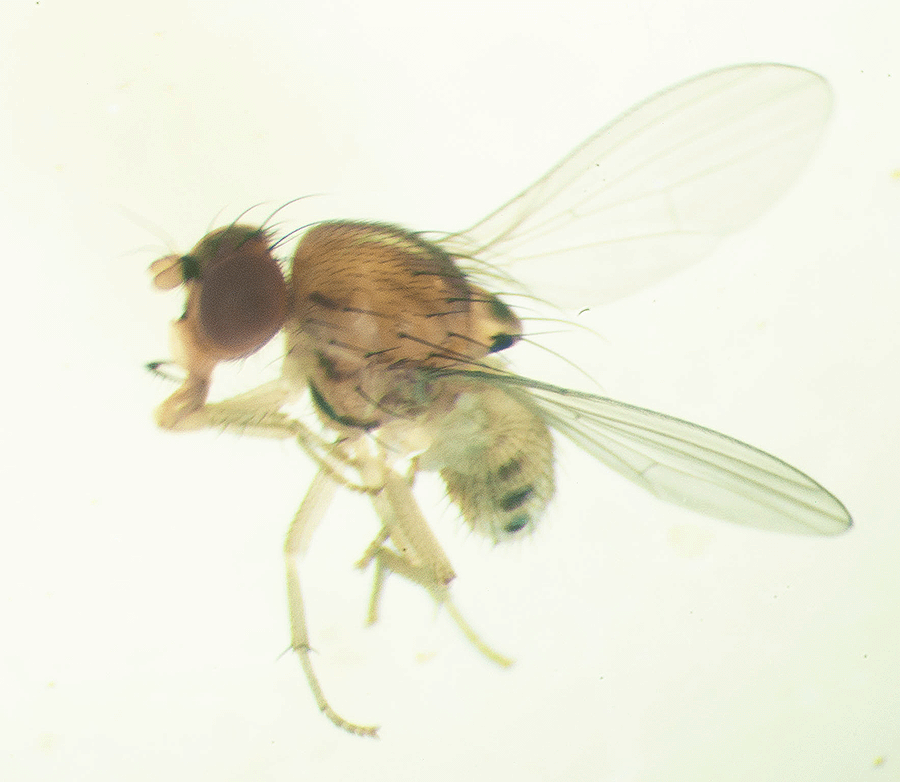










 On December 8, 2014, this 3 mm Muscid was captured in a sweep net sample collected in the dry, seasonal pond, dominated by grasses and sedges.
On December 8, 2014, this 3 mm Muscid was captured in a sweep net sample collected in the dry, seasonal pond, dominated by grasses and sedges.  On July 30, 2015, the fly was identified as Atherigona sp. by Martin Hauser, Contributing Editor to <Bugguide.net>.
On July 30, 2015, the fly was identified as Atherigona sp. by Martin Hauser, Contributing Editor to <Bugguide.net>. In November 2012, this 4.25 mm long fly was captured with a sweep net south of the Smith Preserve pond.
In November 2012, this 4.25 mm long fly was captured with a sweep net south of the Smith Preserve pond. 

 It is suspected that both flies shown here are the same species. The first fly, shown in the first two photographs was quite small and resting on the top of a saw palmetto frond on April 23, 2014. On November 26, 2014, it was identified from these photographs as probably a predatory species of Family Muscidae, by John F. Carr, a Contributing Editor of <BugGuide.net>, sponsored by Iowa State University Department of Entomology.
It is suspected that both flies shown here are the same species. The first fly, shown in the first two photographs was quite small and resting on the top of a saw palmetto frond on April 23, 2014. On November 26, 2014, it was identified from these photographs as probably a predatory species of Family Muscidae, by John F. Carr, a Contributing Editor of <BugGuide.net>, sponsored by Iowa State University Department of Entomology. 


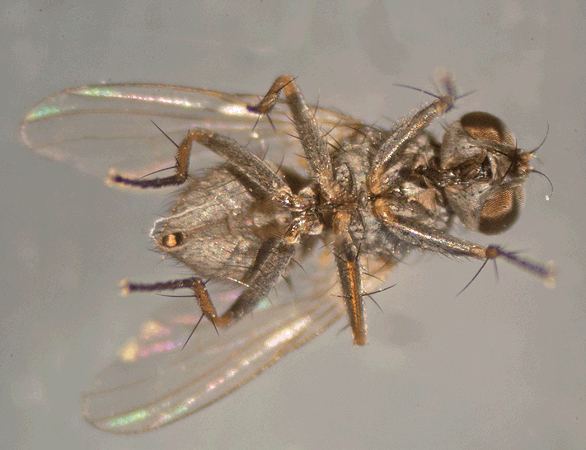
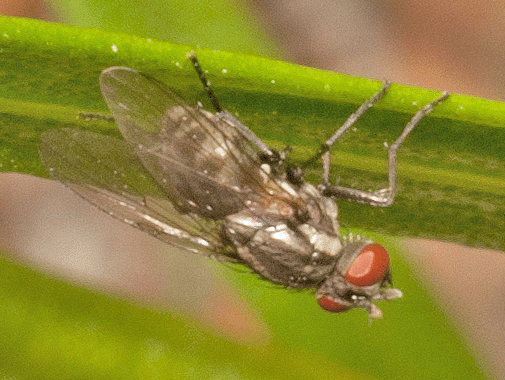
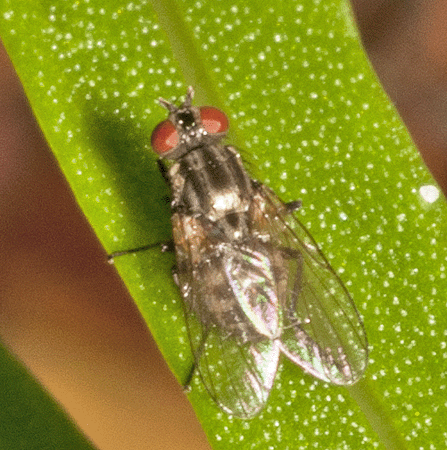 On February 27, 2017, this small fly was photographed as it rested on the bottom of a leaf of
On February 27, 2017, this small fly was photographed as it rested on the bottom of a leaf of 

 As was stated above for an earlier described member of this family, a
As was stated above for an earlier described member of this family, a


 These images were created using photomicroscopy and sent to <BugGuide.net>, sponsored by Iowa State University's Department of Entomology for identification.
These images were created using photomicroscopy and sent to <BugGuide.net>, sponsored by Iowa State University's Department of Entomology for identification. 

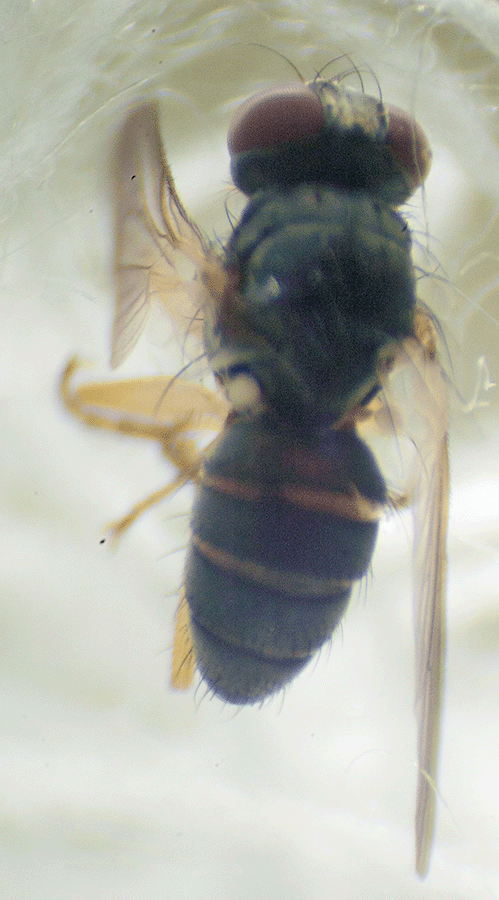
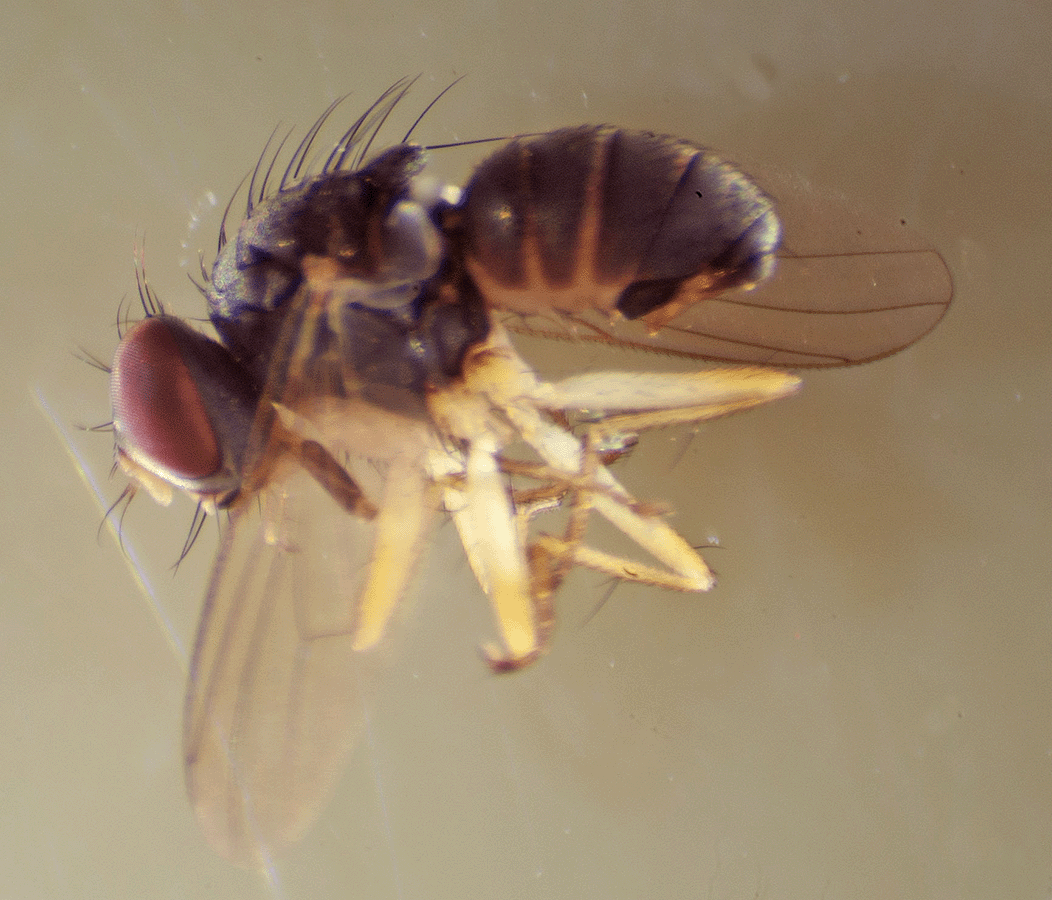





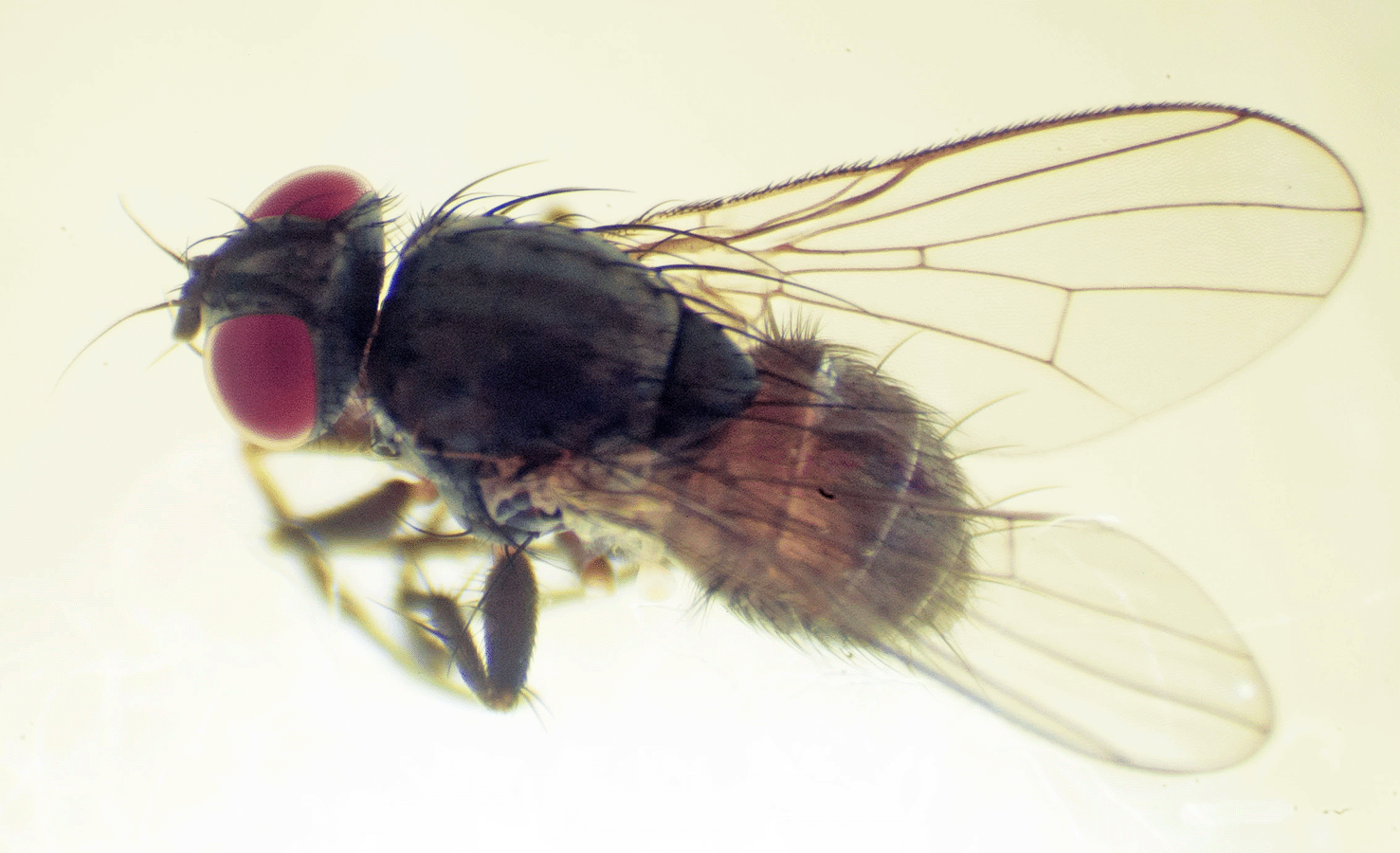





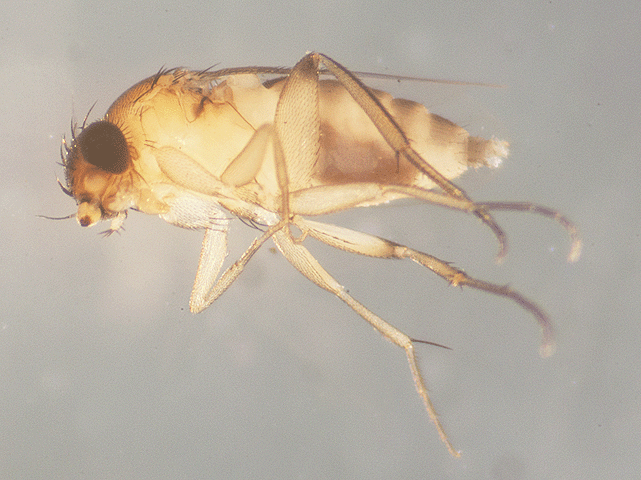 Family Phoridae consists of small, hump-backed flies that resemble fruit flies. Unlike most flies, to escape, they often run rapidly along a surface instead of flying away. This behavior is the origin of one of its common names, "scuttle fly." There are ~4,000 species in 230 genera in this family.
Family Phoridae consists of small, hump-backed flies that resemble fruit flies. Unlike most flies, to escape, they often run rapidly along a surface instead of flying away. This behavior is the origin of one of its common names, "scuttle fly." There are ~4,000 species in 230 genera in this family.





















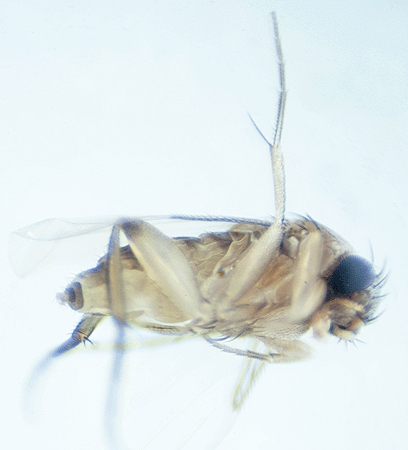




 On January 4, 2017, this 2.5 mm long fly was caught in a yellow bowl trap left overnight just south of Smith Preserve Way in the middle of the Preserve, just west of the seasonal pond.
On January 4, 2017, this 2.5 mm long fly was caught in a yellow bowl trap left overnight just south of Smith Preserve Way in the middle of the Preserve, just west of the seasonal pond. 






 The family name Sciaridae comes from the Greek word "skiaros" which means "dark; shady," and refers to this gnat's wing coloration. More than 2.500 species have been described worldwide. All have slender bodies, long legs and antennae with 8 to 16 segments.
The family name Sciaridae comes from the Greek word "skiaros" which means "dark; shady," and refers to this gnat's wing coloration. More than 2.500 species have been described worldwide. All have slender bodies, long legs and antennae with 8 to 16 segments. This particular female gnat was 2.5 mm long and captured in a sweep net in the southwest portion of a mostly dry seasonal marsh at the Smith Preserve on December 8, 2014. The marsh is filled with grasses and sedges.
This particular female gnat was 2.5 mm long and captured in a sweep net in the southwest portion of a mostly dry seasonal marsh at the Smith Preserve on December 8, 2014. The marsh is filled with grasses and sedges. On January 18, 2020, this 1.25 mm long male gnat was captured in a pitfall trap that was placed in sand and left overnight in the Preserve, just north of Smith Preserve Way. The trap was placed adjacent to a gopher tortoise burrow and a light pole.
On January 18, 2020, this 1.25 mm long male gnat was captured in a pitfall trap that was placed in sand and left overnight in the Preserve, just north of Smith Preserve Way. The trap was placed adjacent to a gopher tortoise burrow and a light pole.  the family was identified by John F. Carr, a Contributing Editor of <BugGuide.net>.
the family was identified by John F. Carr, a Contributing Editor of <BugGuide.net>. As explained
As explained 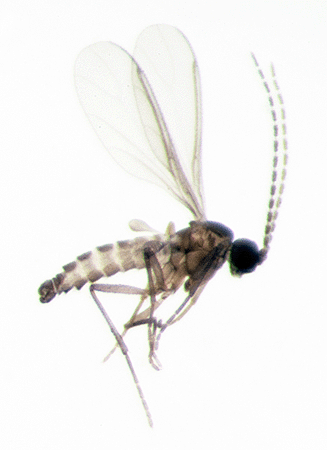
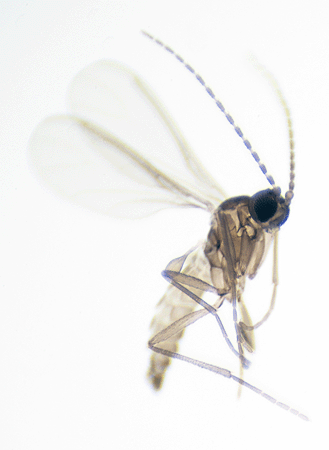


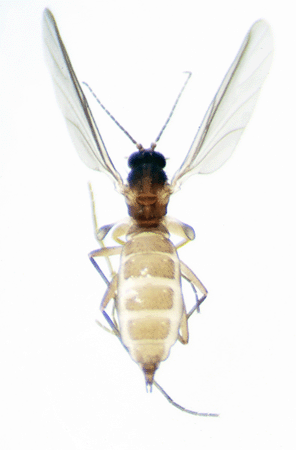

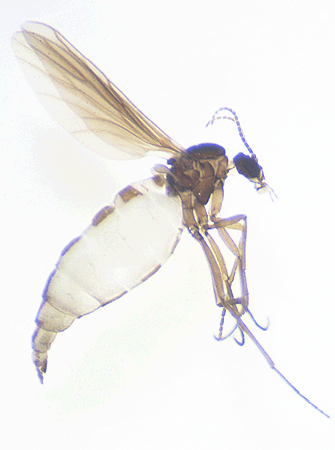

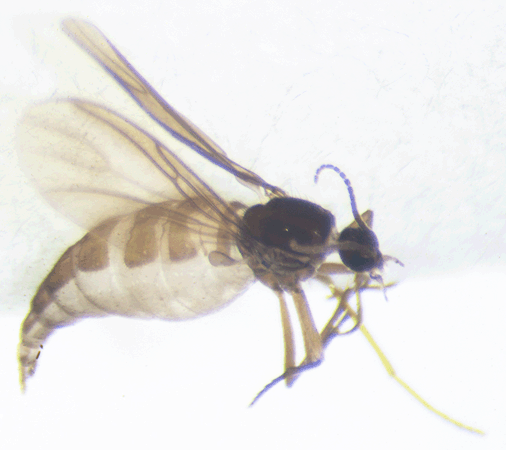 In December 2016, this female fungus gnat was found in the Smith Preserve.
In December 2016, this female fungus gnat was found in the Smith Preserve. 


 ology Department.
ology Department.
 On January 6, 2013, this species was confirmed from these photographs by Kelsey J. R. P. Byers, contributing editor of <bugguide.net>, hosted by Iowa State University Entomology Department.
On January 6, 2013, this species was confirmed from these photographs by Kelsey J. R. P. Byers, contributing editor of <bugguide.net>, hosted by Iowa State University Entomology Department. 

 On November 20, 2014, this fly was photographed while it visited a flower of
On November 20, 2014, this fly was photographed while it visited a flower of 
 This species pollinates flowers and is a particularly common pollinator of the non-native, very invasive Schinus terebinthifolius (Brazilian Pepper)
This species pollinates flowers and is a particularly common pollinator of the non-native, very invasive Schinus terebinthifolius (Brazilian Pepper) 
 Many female tachinids lay their eggs or larvae directly on the host insect or forcibly inject the eggs or larvae into the host. Some tachinid females "broadcast" hundreds of tiny eggs onto vegetation, hoping that when the eggs hatch, they will be consumed with the foliage by a host caterpillar. In some species, the eggs are laid on vegetation, the eggs hatch, and the larvae actively stalk the host. Once the larvae are inside the host, they eat its tissue. Eventually the larvae emerge from the host and pupate. By the time they emerge, most of the host's tissues are gone, and the host dies. Some host-specific tachinid flies have been used in biological control of harmful insects.
Many female tachinids lay their eggs or larvae directly on the host insect or forcibly inject the eggs or larvae into the host. Some tachinid females "broadcast" hundreds of tiny eggs onto vegetation, hoping that when the eggs hatch, they will be consumed with the foliage by a host caterpillar. In some species, the eggs are laid on vegetation, the eggs hatch, and the larvae actively stalk the host. Once the larvae are inside the host, they eat its tissue. Eventually the larvae emerge from the host and pupate. By the time they emerge, most of the host's tissues are gone, and the host dies. Some host-specific tachinid flies have been used in biological control of harmful insects. This fly was photographed on
This fly was photographed on  Most female tachinids deposit their eggs directly on the body of the host. Upon hatching, larvae burrow into and feed on the internal organs of the host. Parasitoids, unlike parasites, eventually kill the host organism. Full-grown larvae leave the host, pupate nearby, and eventually emerge from the pupal casings as adults.
Most female tachinids deposit their eggs directly on the body of the host. Upon hatching, larvae burrow into and feed on the internal organs of the host. Parasitoids, unlike parasites, eventually kill the host organism. Full-grown larvae leave the host, pupate nearby, and eventually emerge from the pupal casings as adults. 
 This fly was identified as a member of Family Tephritidae by John F. Carr (Contributing Editor of <bugguide.net>, hosted by Iowa State University Entomology Department), on November 30, 2013.
This fly was identified as a member of Family Tephritidae by John F. Carr (Contributing Editor of <bugguide.net>, hosted by Iowa State University Entomology Department), on November 30, 2013. 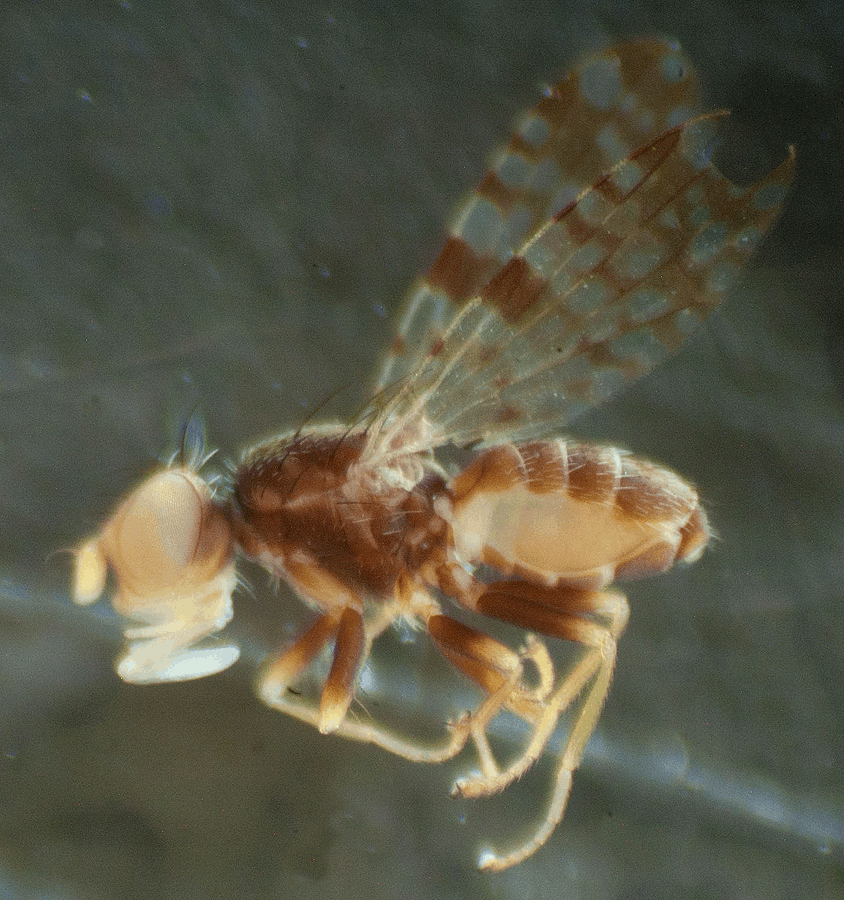 On November 12, 2012, this 2.75 mm long fly was captured with a sweep net in tall grasses in the Smith Preserve.
On November 12, 2012, this 2.75 mm long fly was captured with a sweep net in tall grasses in the Smith Preserve. 
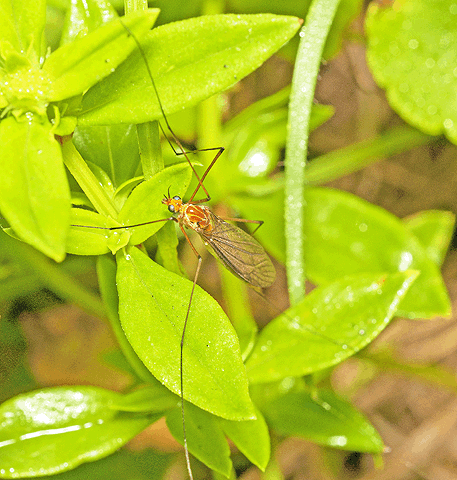

 Individual adult crane flies have very long, skinny legs that can support them on the surface of water, but many are not aquatic. Sometimes an individual crane fly will have fewer than six legs because it has shed a few when stressed. Some species feed on nectar as adults; others eat nothing. Crane flies are attracted to lights at night.
Individual adult crane flies have very long, skinny legs that can support them on the surface of water, but many are not aquatic. Sometimes an individual crane fly will have fewer than six legs because it has shed a few when stressed. Some species feed on nectar as adults; others eat nothing. Crane flies are attracted to lights at night. 





